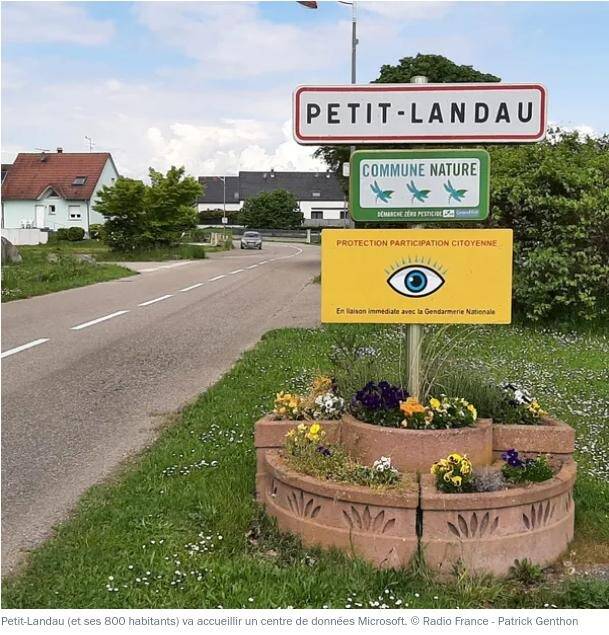Since the end of 2023, the Marseille collective Le Nuage était sous nos pieds (The cloud was beneath our feet) has been investigating, analysing and fighting against the social, ecological and political impacts of digital infrastructures in Marseilles, in particular international undersea cables and data centres. The collective is made up of Marseille residents affiliated to at least three organisations: the collectif des Gammares a Marseille collective for popular education on water issues, Technopolice Marseille which analyses and fights against police surveillance technologies, and La Quadrature du Net, an association for the defence of fundamental freedoms and rights in the digital environment. In this article, we present part of the collective’s investigation into digital infrastructures in Marseille, their socio-environmental impact and the noxious world they represent, an investigation that we are extending beyond the Marseilles area, inspired in particular by the debates at the Le nuage était sous nos pieds festival that took place on 8, 9 and 10 November 2024 in Marseille.
Some sixteen intercontinental submarine cables arrive in Marseille today, landing, transiting and linking Europe and the Mediterranean to Asia, the Middle East, Africa and the United States. It is these intercontinental cables that enable digital information to circulate, particularly on the Internet, and the digital services deployed in what is known as the ‘cloud’ to appear on our screens: emails, social networks, streaming videos and films. At the crossroads of these ‘information superhighways’ are the data centres. These concrete overheating mega-computers contain thousands of servers that make technocapitalism and its invisible digital data possible: the massive collection of personal data used to analyse our behaviour, which is constantly tracked and processed for marketing purposes; digital advertising that pollutes our brains; police video surveillance and, more broadly, algorithmic governance and surveillance boosted by artificial intelligence that discriminates against and undermines our fundamental freedoms. Behind these infrastructures, there is also the grabbing of land and water resources, but also air pollution, the concreting of our heated cities, and the blood-stained realities of colonial digital extractivism that the server chips that populate these data centres contain. And once again, it is unscrupulous industries, aided and abetted by shameful policies, that are taking over our territories and our lives.
Data centres and transcontinental submarine cables
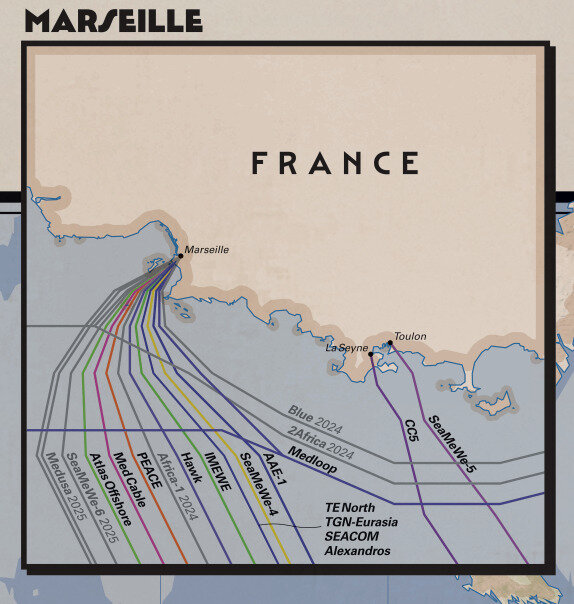
Map of transcontinental submarine cables arriving in Marseille today. Source: Telegeography, Submarine Cable Map.
The presence of these 16 intercontinental submarine cables in Marseille attracts data centres, these giant warehouses where thousands of servers are stacked, belonging for the most part to Google, Amazon, Microsoft, Meta, Netflix, Disney+, Capgemini, Thalès, etc. Servers that store and transmit data, servers that make possible the digital services and data exchanges described above. Over the past ten years, and more rapidly since 2020, a dozen data centres have been built all over the inner city of Marseille, and several new ones are under construction or planned in and around the city. These include five data centres owned by Digital Realty, an American real estate investment giant listed on the stock exchange and specialising in the management of so-called network-neutral, carrier-neutral or colocation data centres. The presence of these 16 intercontinental submarine cables in Marseille attracts data centres, these giant warehouses where thousands of servers are stacked, belonging for the most part to Google, Amazon, Microsoft, Meta, Netflix, Disney+, Capgemini, Thalès, etc. Servers that store and transmit data, servers that make possible the digital services and data exchanges described above. Over the past ten years, and more rapidly since 2020, a dozen data centres have been built all over the inner city of Marseille, and several new ones are under construction or planned in and around the city. These include five data centres owned by Digital Realty, an American real estate investment trust listed on the stock exchange and specialising in the management of so-callednetwork-neutral, carrier-neutral or colocation data centres. This company builds, fits out and manages the building’s operations, and then rents out the server locations to other companies, such as Microsoft, Amazon, Google, Netflix and others. These colocation data centres are well established in France, but in other countries and territories, Amazon, Microsoft, Google and other digital giants build their own data centre buildings and all the infrastructure they need to operate them: electrical substations, terrestrial fibre networks, transcontinental submarine cables, etc.
In Marseilles, the giant Digital Realty, one of the world’s three leading colocation data centres, has four data centres, MRS1, MRS2, MRS3 and MRS4, and is in the process of building a fifth, MRS5, all located within the Grand Port Maritime de Marseille (GPMM). The other data centres in Marseille are often located in the north of the city. In the Saint-Henri district in particular, where a Free Pro colocation data centre is currently being expanded to double its size, sharing space with a Telehouse data centre. In the Saint-André district, an oversized data centre project by Segro has just been announced. While at Belle-de-Mai a data centre by Phocea DC is under construction. There’s even a project for a floating data centre in the Grand Port, by the company Nautilus! Outside the municipal boundaries, in Bouc-Bel-Air, Digital Realty also has a project to build a sixth data centre, much larger than the previous ones, called MRS6.
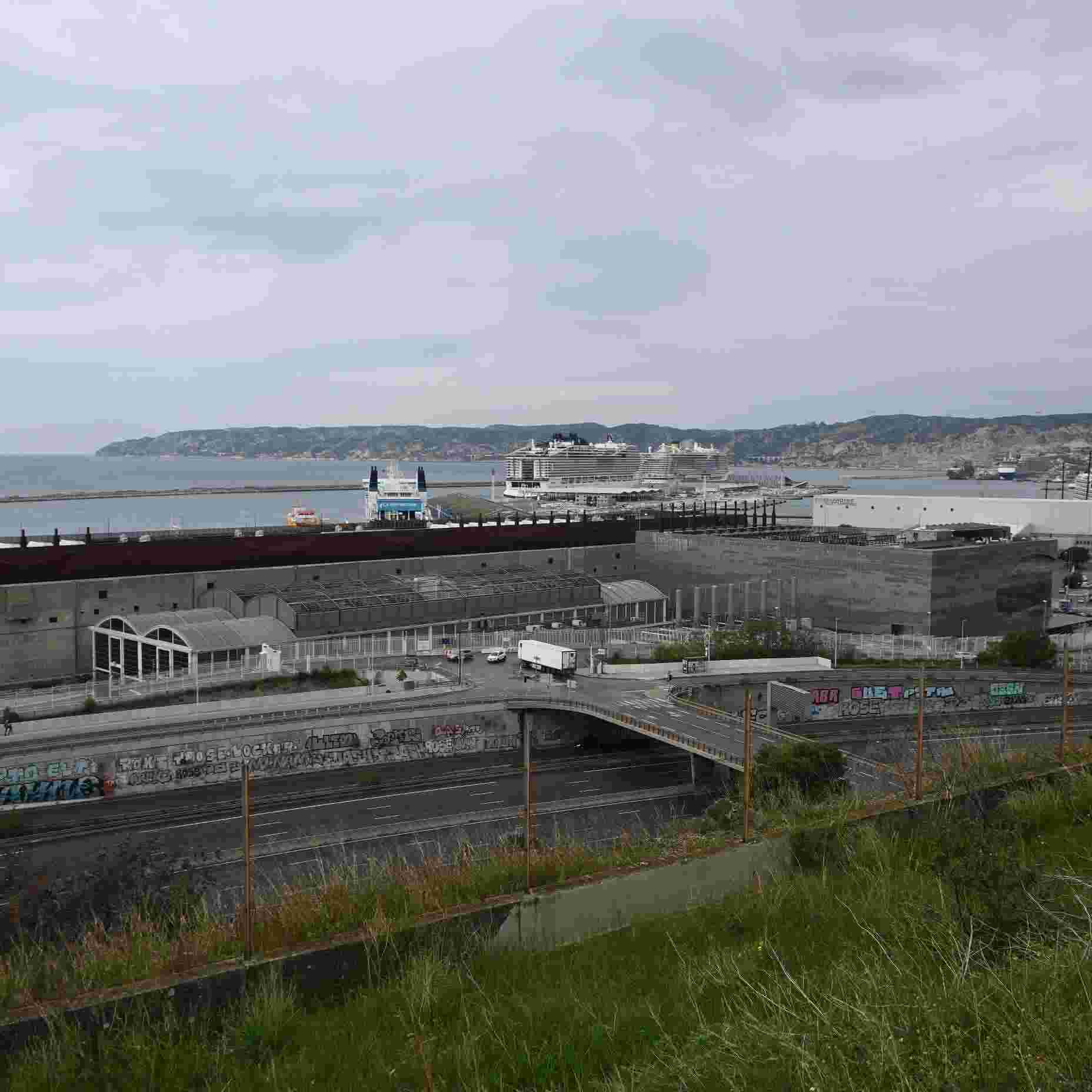
View of Digital Realty’s MRS2, MRS3 and MRS4 data centres in Marseille’s Grand Port Maritime, from Cap Janet in the Calade district. Photo taken during the Le nuage était sous nos pieds festival walk, 9 November 2024.
Marseille is not the only city concerned. France, with its 300-plus data centers, is now the world’s 6th largest host country, after the USA, Germany, the UK, China and Canada. In the Île-de-France region, France’s leading location with more than 160 data centers in 2023, just ahead of Lyon (18) and Marseille (12), Digital Realty has 2 hubs with a total of 17 data centers (and several more under construction), mostly concentrated in Seine-Saint-Denis. Equinix, another giant in the world’s top 3 colocation data centers, owns 10, while Data4, Scaleway or Free Pro, OVH, Telehouse, Verizon, Zayo and other players share the remaining 72.
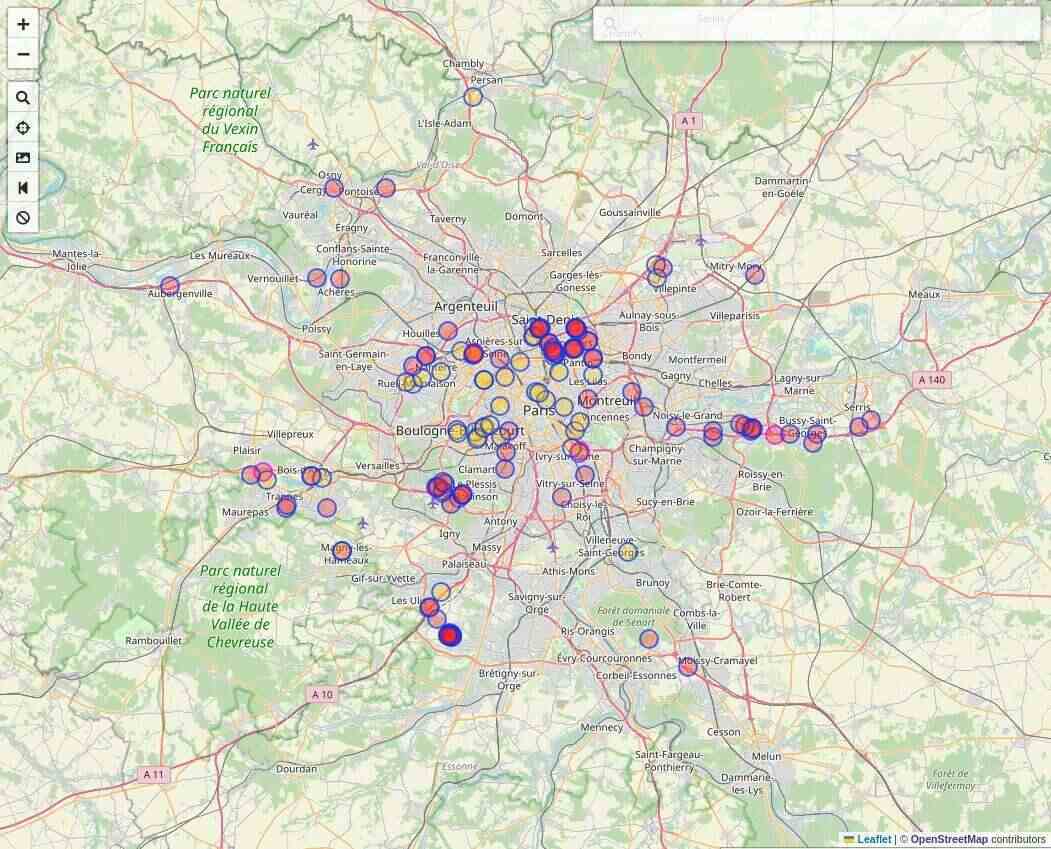
Map of data centers in the Île-de-France region, visible on OpenStreetMap, using the Overpass query https://overpass-turbo.eu/s/1Ulj.
The sixteen intercontinental submarine cables arriving in Marseilles today are listed by Telegeography, an entity that maintains Submarine Cable Map, one of the world’s reference maps for this type of cable. They are built and deployed within international consortia comprising several digital companies and multinationals. First and foremost are the digital giants – Google, Facebook/Meta, Microsoft and Amazon – who are now the biggest financiers and the main players in the deployment of these intercontinental submarine cables. They also include telecoms companies such as Orange, as well as international operators, who will often be in charge of landing the cables on beaches, as well as cable landing stations or centers, enabling the transition between the submarine infrastructures and the terrestrial cable network. There are also companies that manufacture and deploy these cables at sea, such as Alcatel Submarine Networks, which has just been acquired by the French government and is one of the three world leaders in this field, along with TE SubCom (Switzerland) and NEC Corporation (Japan).
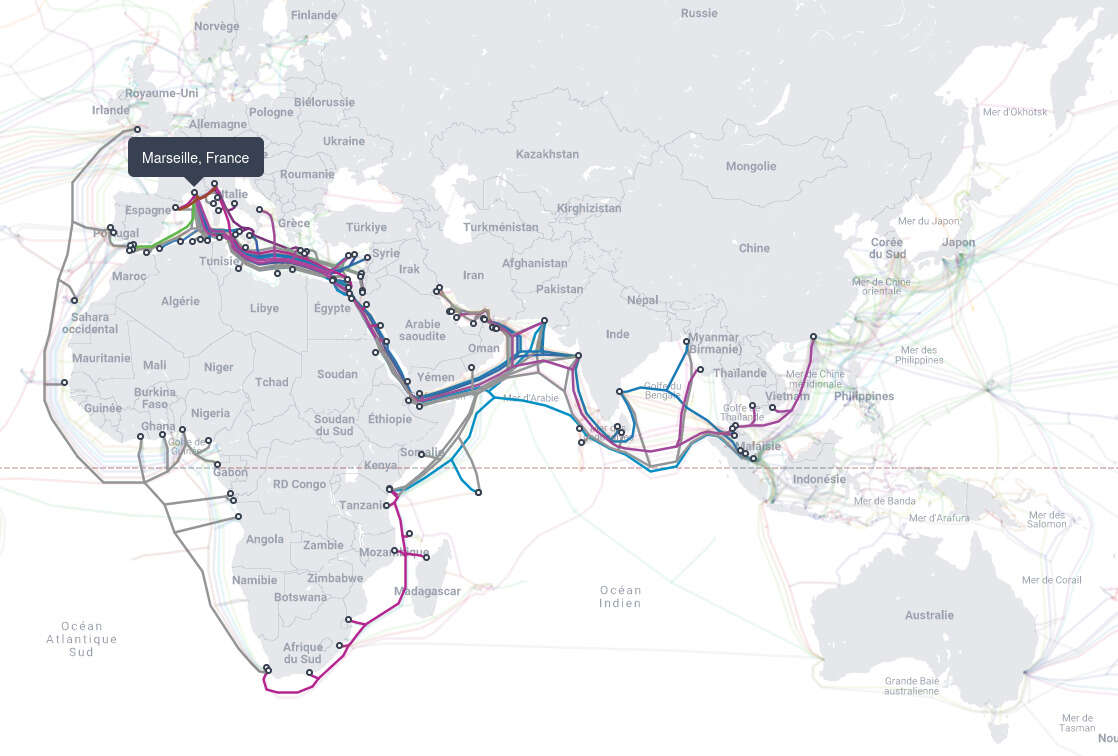
Map of transcontinental submarine cables in Marseille. Source: Telegeography Submarine Cable Map 2024.
The digital giants’ stranglehold
These submarine cables and their landing centers are now strategic infrastructures, with major geopolitical stakes worldwide, but where the domination of digital giants is also becoming the norm. In Marseilles, for example, most of the new submarine cables built or under construction in recent years have as their main player Facebook (2Africa), Google (Blue), and Microsoft (SeaMeWe-6). Among the telecoms operators and Internet service providers from all over the world that the presence of intercontinental submarine cables also attracts to Marseille is the French multinational Orange, which has at least one data center in the city for its own needs, as well as several submarine cable landing centers.cable landing stations. We also have the presence of Verizon, an American telecom operator with a data center coupled to a submarine cable landing center, and Omantel, Oman’s national telecom company, which also has one – to name just a few of the operators identified by the survey and mapping of digital infrastructures in Marseille carried out by the Le Nuage était sous nos pieds collective. You can find out more about this mapping work carried out in the field, and using on the free, collaborative map OpenStreetMap, on this map created during this investigation.
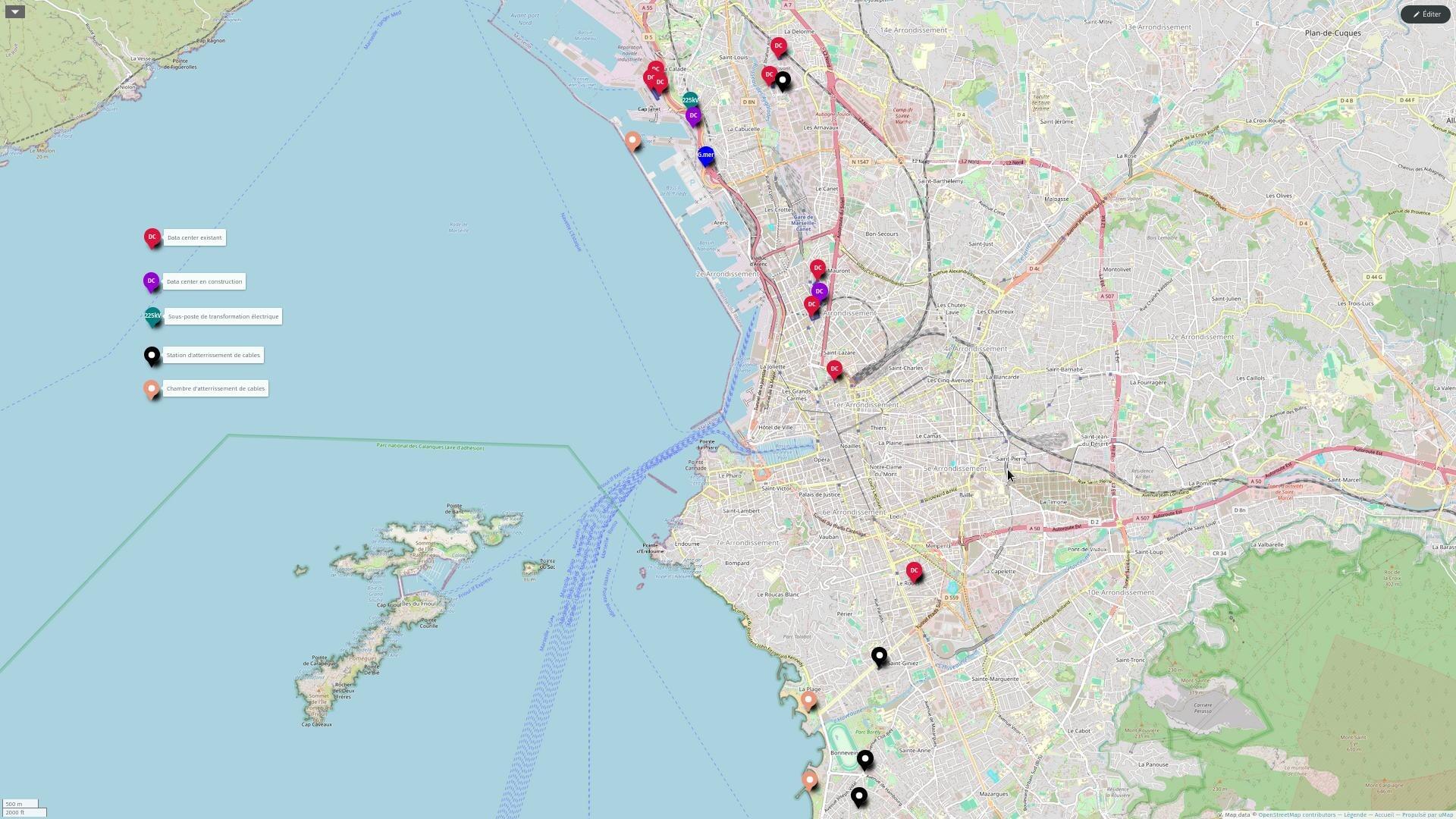
Map of digital infrastructures in Marseille. Mapping work based on OpenStreetMap and field observations from the Le nuage était sous nos pieds collective.
Marseille also boasts a significant number of Internet eXchange Points (IXP), physical infrastructures where telecom operators, Internet Service Providers (ISPs) and companies offering digital services connect and exchange cost-free traffic through mutual agreements. So, as Stéphane Bortzmeyer explains in
There are at least 6 IXP points of presence in Marseille today, as can be seen from this freely accessible European database. The Marseilles IXPs all appear to be located in Digital Realty data centers, and for each of them (Points of Presence tab) you can see the list of digital players connected there: TikTok, Google Cloud, Amazon Web Services, Disney+, Netflix, Zoom, the list of the usual giants goes on and on. The proximity of these IXPs to the transcontinental submarine cables in Marseille ensures optimal latency and bandwidth, while their presence within the data centers themselves, as close as possible to the digital services that exploit the space there, is also an additional marketing argument for Digital Realty. On a national level, Paris, with its dozen IXPs, is, along with Marseille, the area where most IXPs are located, ahead of other major metropolises. The locations and specific features of IXPs worldwide can also be found on this map maintained by Telegeography.
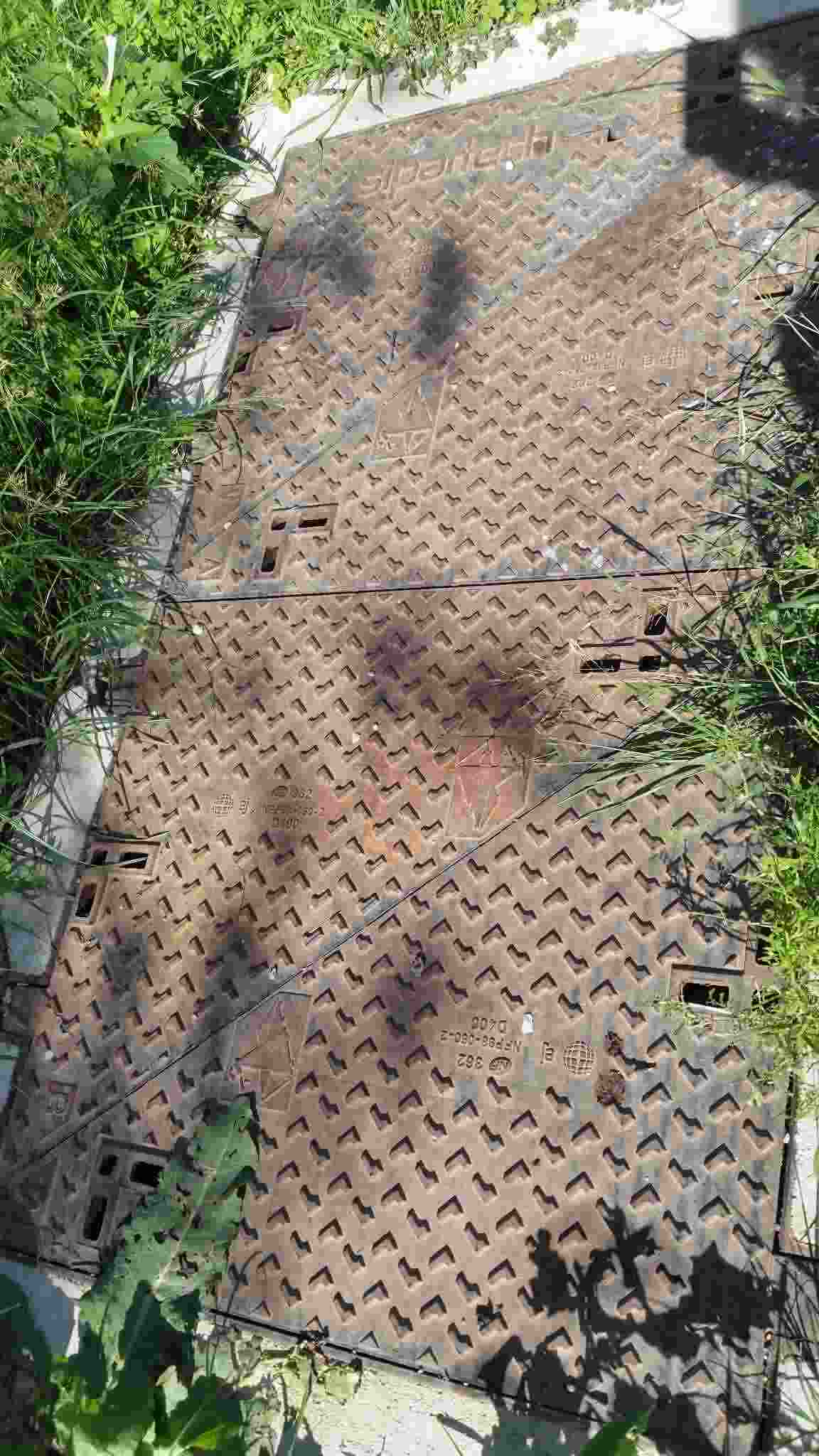
Photo of a Beach Manhole for the AAE-1 intercontinental submarine cable located on the Vieille Chapelle beach in Marseille, managed by Omantel and Sipartech.
All the intercontinental submarine cables, Internet eXchange Points and data centers hosting the many digital services of the world’s leading companies in the sector make Marseille France’s second largest digital hub after Paris, and the 7th largest in the world today, on the way to becoming the 5th.
Data centers: an opportunistic territorial presence and more-than-welcoming state policies
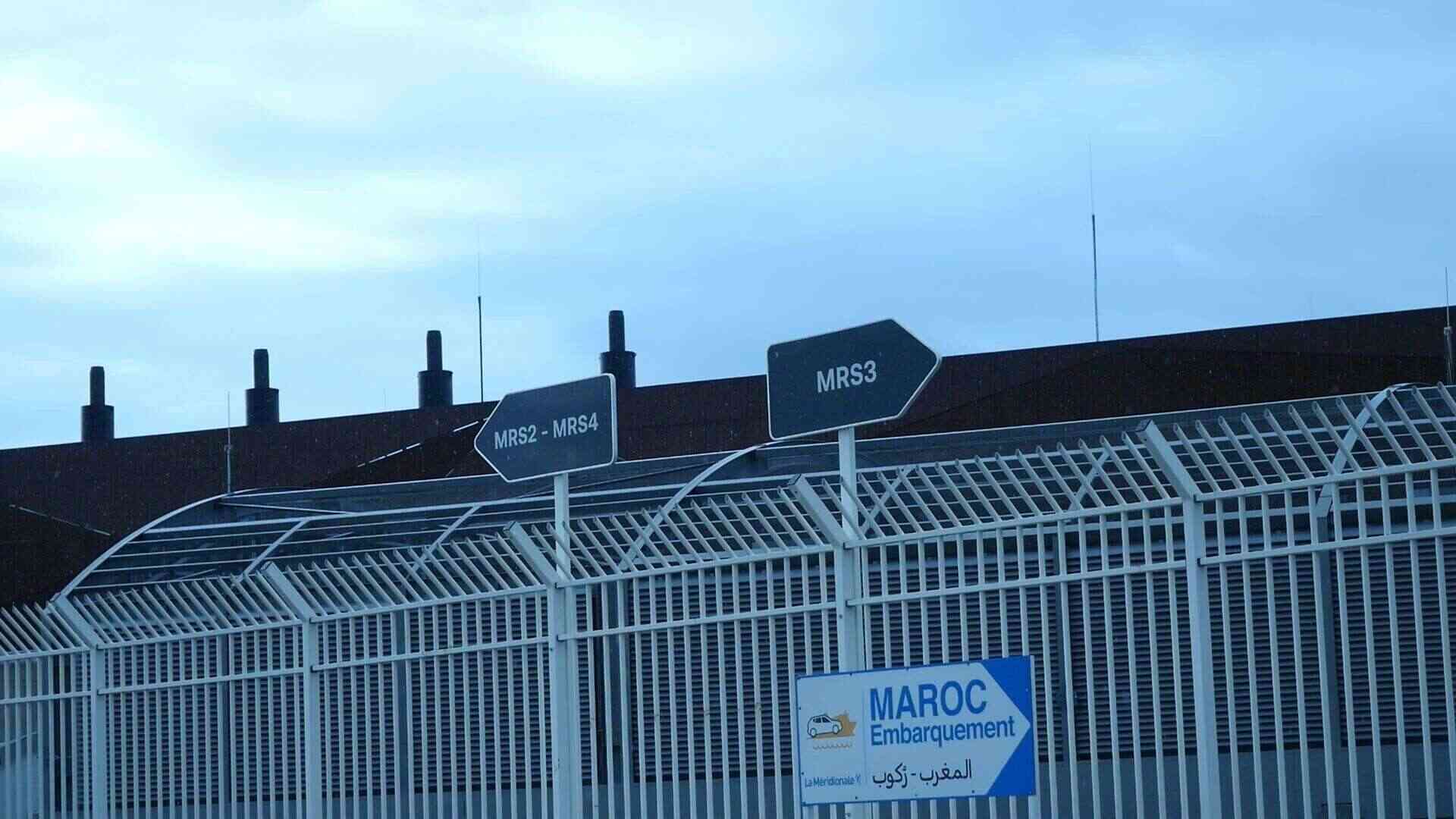
View of the Grand Port Maritime de Marseille, with the roof of the MRS3 data center in the background. Source: photo taken during the Le Nuage était sous nos pieds festival walk, November 9, 2024.
All over the world, data centers are set up opportunistically, taking advantage of the specific features of each region. In Marseille, for example, it’s the presence of submarine cables for transcontinental Internet links, as well as the presence of major telecoms players and Internet exchange points. But it’s also an inexpensive land opportunity within the territory of the Grand Port Maritime de Marseille, this public industrial and commercial establishment (EPIC) directly under the supervision of the State, managed like a company, and which finds in these digital data warehouse projects a lucrative mutation opportunity for its real estate assets, formerly occupied by port activities in decline. As Christophe Castaner, Chairman of the GPMM Supervisory Board, who looks after the State’s interests in Marseille, likes to point out, the “French smartport of Marseille-Fos […] is paving the way for the concept of a maritime data hub”, and is an entrepreneurial port that “fears above all its deindustrialization”.
But generally speaking, as the France Datacenters association, the largest lobbying organization in the field, likes to say, France is “the ideal destination”, a veritable “data center nation”. Indeed, as the association explains in this vidéo promotionnellepromotional video, France boasts solid, diversified economic sectors, such as digital and telecommunications, finance, automotive and aeronautics, all of which are driving forces behind data centers.
The French government has, she continues, launched numerous initiatives and fundings dedicated to the digitization of industries (10 billion dedicated to the digital sector in recent years), enabling the data center sector to grow twofold between 2016 and 2021, with one billion euros of annual investment. But also, and above all, inexpensive and easily accessible land, low-cost electrical energy (the second cheapest in Europe, with an average of 84 euros per megawatt-hour in 2020) and low carbon emissions (because it’s mostly nuclear). France’s network infrastructure, with its fiber-optic network, 5G and intercontinental cables, is also presented as a major asset with low access costs. France’s electricity infrastructure is presented as highly developed and solid, with no infrastructure maintenance costs for data centers, as it is maintained by state-owned companies RTE and Enedis, which have pledged to invest over €100 billion in this infrastructure by 2035. The video also underlines the fact that industries in France enjoy numerous tax advantages, and even regional funding for their location.
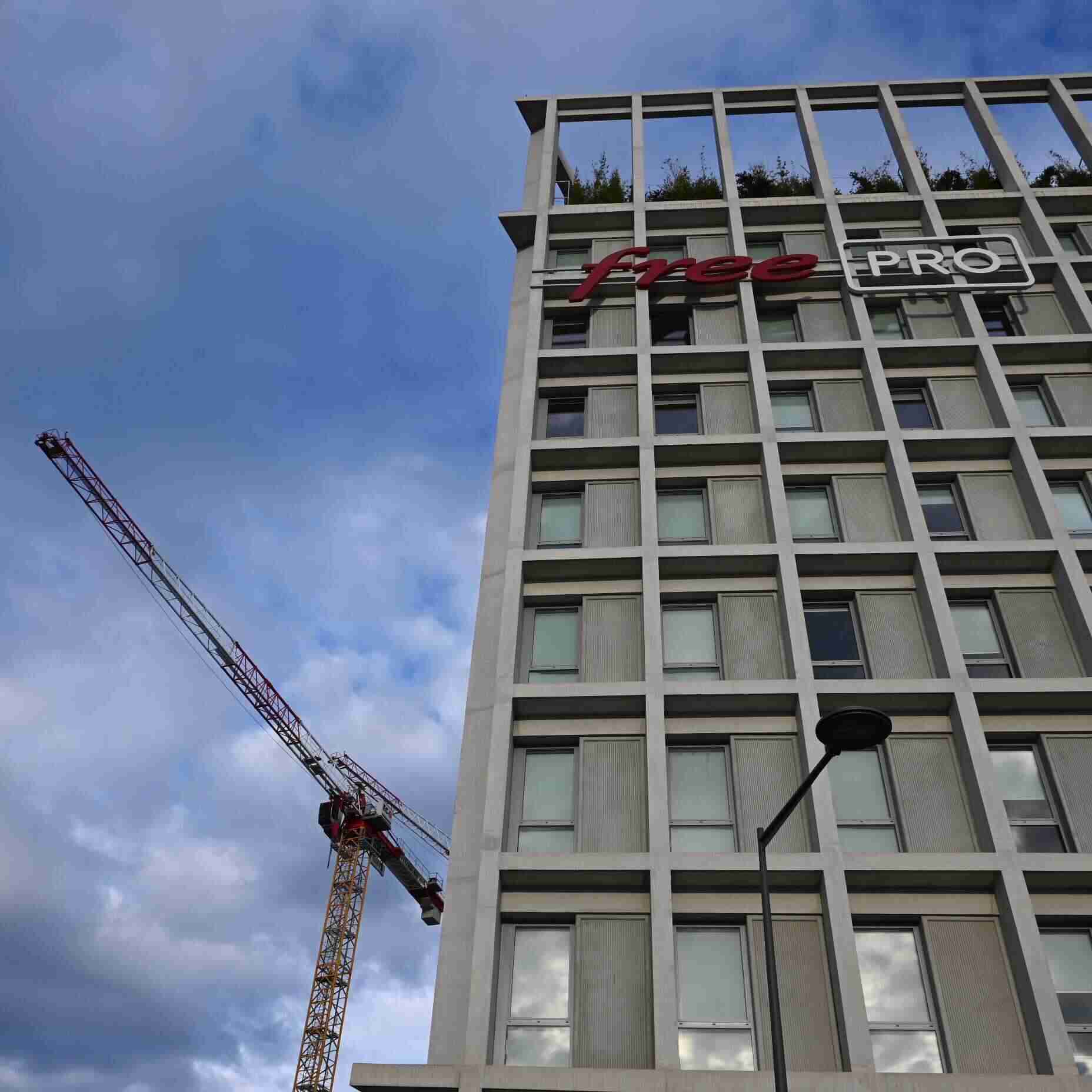
Photo of the Free Pro headquarters building in Marseille’s newly built Smartseille district. Photo taken during the Le nuage était sous nos pieds festival walk on November 9, 2024.
France’s data centers lobby can indeed count on favorable policies. In 2018 the National Assembly voted, on the proposal of MP Bothorel, a tax aid for data centers, consisting in applying a reduced rate to the domestic tax on final electricity consumption (TICFE), usually 22.5 euros per megawatt-hour (MWh), which will then be divided by 2 for them, i.e. 12 euros per megawatt-hour, beyond the first GWh consumed. In 2019, former Economy Minister Bruno Le Maire, at the inauguration in Pantin of an Equinix data center, hosting, among some American giants, also the Docaposte (La Poste group) and the SNCF servers, declared:
Our ambition is for France to become the leading host country for data centers in Europe. […] Setting up data centers in France is a necessity if we are to accelerate access for businesses to the tools of digital transformation, and a sovereignty issue if we are to keep sensitive corporate data in France.
Two years later, in 2021, the Minister, accompanied by Cédric O, then Secretary of State for Digital, launched, as part of the “France Relance” Plan, the national acceleration strategy for the Cloud :
With a budget of 1.8 billion euros, including 667 million euros in public funding, 680 million euros in private co-financing and 444 million euros in European funding, […] aims to strengthen support for the French cloud industry’s offerings and capitalize on innovation and the strengths of the French cloud ecosystem, […] accelerating the [bold in text] scaling-up of French players in critical technologies in high demand, such as big data or collaborative working […].
This plan has above all served the GAFAMs and their deeper implantation in our territories. Thus, shortly afterwards, France’s OVH and Dassault Systems entered into a partnership with the “clouds” of Google and Microsoft, which the government approved under cover of their location in data centers in France, to host sensitive data. This is for example what enables the Health Data Hub, the French people’s health data privatization project, which we denounced in 2021, to continue to be hosted by Microsoft, but in data centers located in France until at least 2025, despite numerous contests from civil society and organisations. Orange, meanwhile, has entered into a agreement with Amazon’s cloud AWS in 2020 to “accelerate enterprises’ digital transformation into the AWS cloud“. Google, following the announcement of the cloud strategic plan in 2021, then declared to begin its plan to establish a presence in France, which has now been successfully completed. More recently, on the Elysée website, we can read the announcement of Microsoft’s latest investment plan (4 billion euros in France) to expand its cloud infrastructure dedicated to AI, “the largest to date in the country, to support French growth in the new economy of artificial intelligence” hailed by Emmanuel Macron, who traveled to the company’s French headquarters for the occasion. It reads:
Microsoft unveiled the extension of its cloud and AI infrastructure in France, with the expansion of its sites in Paris and Marseille, which will equip the country with a capacity of up to 25,000 latest-generation GPUs by the end of 2025, and the opening of new sites to host next-generation data centers in the Mulhouse and Dunkirk conurbations.
In Mulhouse, Microsoft’s data center dedicated to AI has already begun construction in Petit-Landau, a village of 800 inhabitants, which ironically has the distinction of Commune Nature, for its “actions geared towards preserving biodiversity and improving water quality in the Rhine-Meuse basin“.
Data centers: overheating concrete mega-computers with multiple environmental hazards
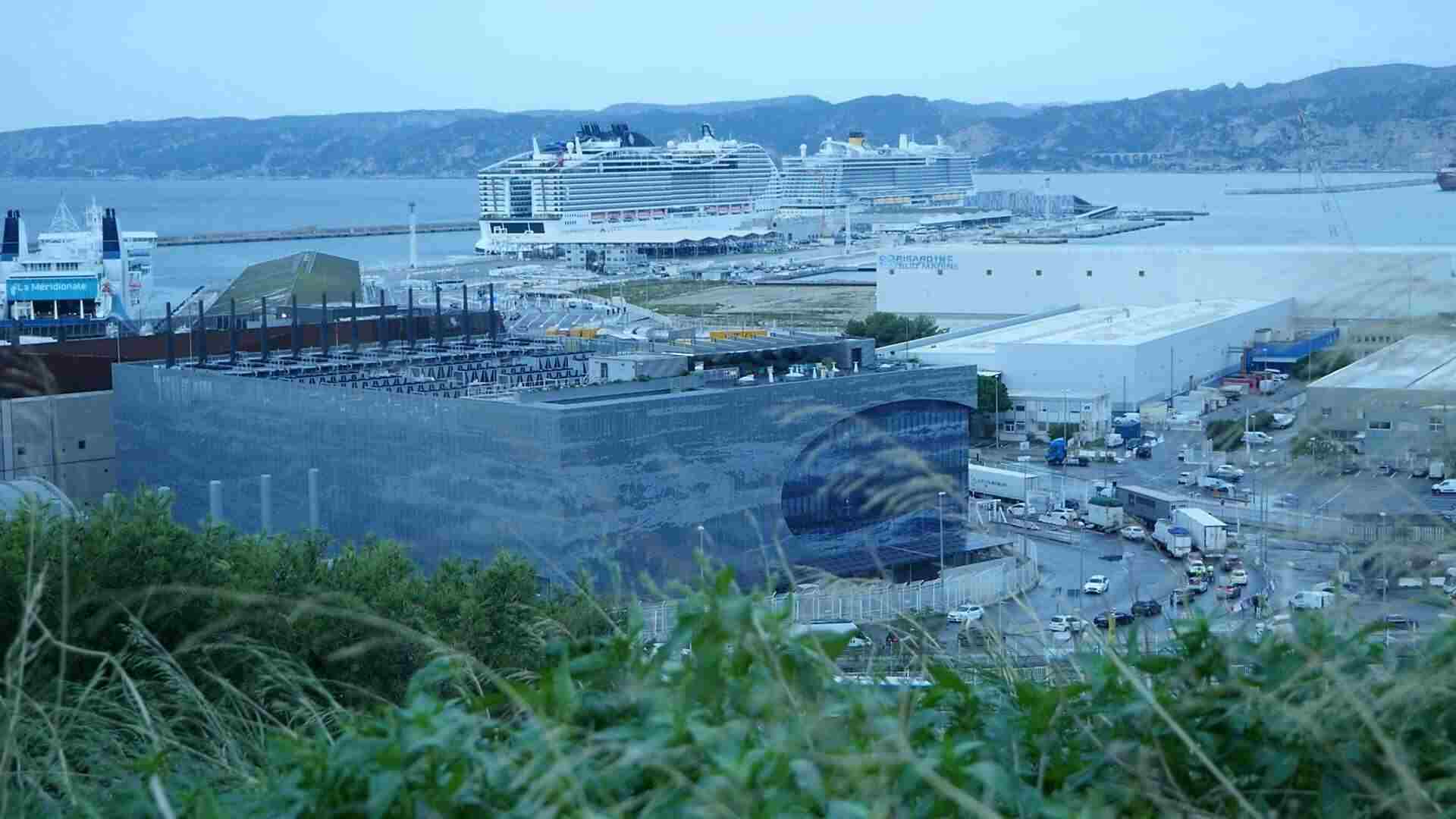
View of Digital Realty’s MRS4 data center in Marseille’s Grand Port Maritime. Photo taken during the walk at the Le Nuage était sous nos pieds festival, November 9, 2024.
There’s nothing cloudy, light or vaporous about a data center, the backbone infrastructure of the so-called “cloud“. On the contrary, these large warehouses are multi-storey concrete buildings, with fortified floors and walls, heavy and massive, to be able to support without risk of collapse the consequent weight of the thousands of servers they house. These servers, which run continuously, use large quantities of electricity. They are each equipped with numerous chips and electronic components, such as processors and graphical cards, which generate large quantities of heat. To keep running smoothly and avoid breakdowns, these servers need an ambient air temperature of no more than 28 degrees Celsius. Often, as a precaution, data centers do not want to exceed 23 – 25 degrees. This is why they are always equipped with air conditioning and ambient temperature cooling systems. These are either conventional systems based on air conditioning using refrigerants, or cooling circuits using the coolness of water. Sometimes, both types of system – air-conditioning and water cooling – coexist in a data center.
Data centers consume large quantities of electricity and water. To meet these needs, they are connected in France to the national electricity grid, and quite often to the drinking water circuits of the city or territories on which they are located. This is the case, for example, of PAR08, the data center of Digital Realty in La Courneuve near Paris, which France director Fabrice Coquio, also riding the Olympic marketing wave, likes to say was very important on the occasion of the Paris 2024 Olympic Games. Built within a complex of four data centers nicknamed the “spaceship”, with a total surface area of 40,000 m² of machine rooms (equivalent to 7 soccer pitches) and 120 Megawatt of electrical power, this data center is now the largest in France. In this report by the Direction régionale de l’environnement, de l’aménagement et du logement (DREAL, Regional directorate for the environment, planning and housing) of Île-de-France, PAR08 is singled out for its massive annual use of 248,091 m3 of water, taken directly from the city of Saint-Denis drinking water circuit, in an area prone to repeated droughts since 2003, as pointed out in this study by the OCD
E (Organisation for Economic Co-operation and Development) in 2023 on “managing the risk of water resource scarcity linked to climate change in the functional urban area of Paris“. This water is used by the PAR08 data center for its adiabatic cooling system, but also to vaporize server rooms that need to maintain optimum hygrometry. In addition to the excessive need for water, the report points to the lack of a plan for water use of PAR08 in the event of drought crises, which is mandatory in such circumstances. But the priority here is once again political and economic, not environmental, this data center having taken advantage of the context linked to the Paris Olympic Games 2024.
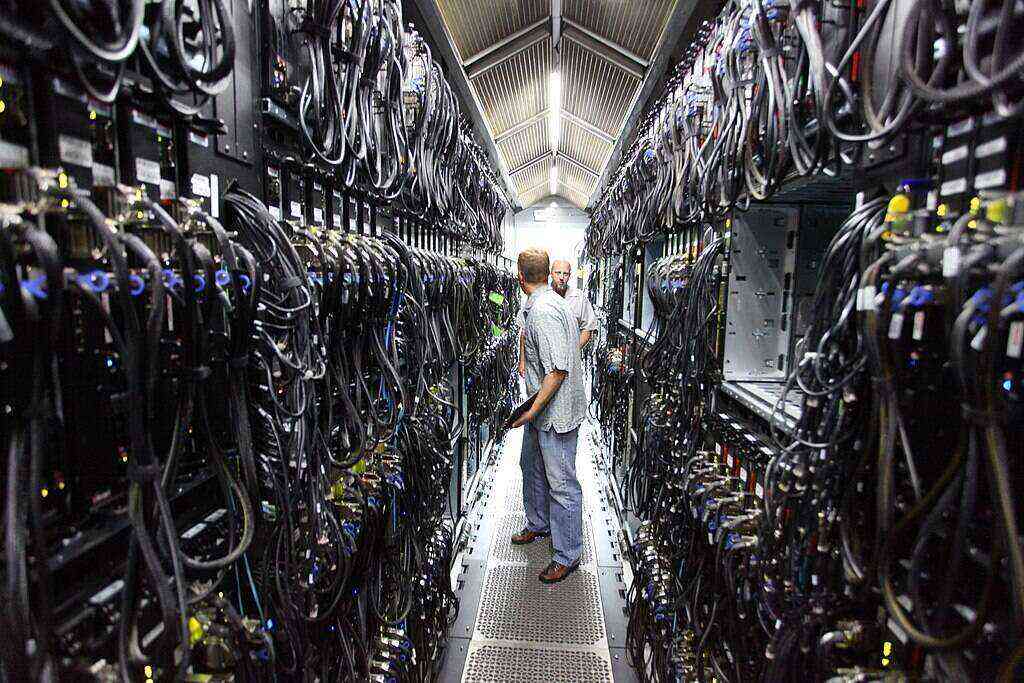
Interior of a Microsoft Bing data center. Robert Scoble, Half Moon Bay, USA, CC BY 2.0 https://creativecommons.org/licenses/by/2.0, via Wikimedia Commons.
These water-cooling systems are now favored by data centers worldwide. Firstly, because purely electric cooling systems, like those operating with refrigerants, are very energy-intensive and therefore have a significant economical cost. Secondly, because water is not a resource that enters into the calculation of the usual environmental impacts of data centers, this being generally solely based on electricity consumption via the Power Usage Effectiveness (PUE), and not its water equivalent, the Water Usage Effectiveness (WUE) which remains not mandatory and very rarely disclosed by data centers.
Sometimes, these cooling systems are not connected to the local drinking water network, but draw drinking water directly from nearby aquifers, rivers or lakes. This is the case, for example, of Facebook’s data center located in the Spanish town of Talaveira de la Reina, in the Castilla-La Mancha region of Spain, which the collective Tu Nube Seca Mi Rio (“Your cloud dries up my river”) is denouncing, among other things for its use of over 200 million liters of water per year, equivalent to the consumption of 4,181 inhabitant⋅es of the region. This is a data center known as a “hyperscaler“, with large dimensions, large data storage and big processing capacities (although there is no consensus on the definition of a hyperscaler). With 248 Megawatts of power, spread over more than 300,000 m2 of land, this giant data center enjoys national and local political support. Although the area in which it is to be located has been under permanent water stress for decades, first because of its geographical location and near-desert climate, and now because of the environmental crisis exacerbating it, the cost per liter of water is low. Here again, the siting of data centers on the territory is governed above all by economic imperatives, and not by social or environmental criteria, for as Aurora Gomez of the collective deplores “These outside companies are imposing themselves and monopolizing resources. This is techno-colonialism! […] The authorities remain deaf to our warnings and pretend not to see us.“.

Image taken from Tu Nube Seca Mi Rio website, the Spanish association fighting against the installation of data centers in Spain: tunubesecamirio.com.
To ensure continuous electrification of servers, data centers have a triple power supply. In addition to being connected to the power grid, they also have generators with fuel oil tanks ready to take over in the event of a power cut, and batteries and other energy accumulators designed to ensure the few seconds of transition between the power grid and generators. All of these devices (servers, cooling system, fuel tanks, batteries) are potentially dangerous for the environment and local residents: refrigerants, which can pollute the air in the event of leaks; noise pollution, inside the building, due to the thousands of servers running constantly, each with several fans, and outside of it, due to the noise and vibrations caused respectively by the cooling systems placed on the roofs or by the electrical transformer substations or the oil-fired generator systems, which are being tested several hours a month. These noise nuisances are regulated in France. Data centers have been concerned and subject to obligations and controls in this area, and have in the past been the subject of several complaints from local residents.
Another source of environmental nuisance are the fuel oil tanks and lithium battery rooms, which pose groundwater pollution risks for the former, and fire risks in both cases. In particular, fires involving these lithium batteries are no ordinary fires: they are far more difficult to extinguish and last much longer, as explained in this article from Reporterre which recounts the multiplied efforts made by firefighters to extinguish this type of fire, or as illustrated by the recent fire at a Digital Realty data center in Singapore, which also recalls the fire at two OVH data centers in Strasbourg in 2021.
It’s because of all these risks that data centers are most often referred to as “Installation classée pour la protection de l’environnement” (Installation classified for environmental protection, ICPE) in France. According to the website of the French Ministry of Ecological Transition, Energy, Climate and Risk Prevention, this ICPE label lists establishments “susceptible of creating risks for third-party residents and/or causing pollution or nuisance vis-à-vis the environment“. As a result of the ICPE classification, data centers are subject to a certain number of regulatory obligations and controls by the Ministry, among others through the decentralized services provided by the DREAL, Direction régionale de l’environnement, de l’aménagement et du logement (Regional directorate for the environment, planning and housing), placed under the authority of the regional prefect and the prefects of the relevant French departement.
Data centers of Digital Realty: repeated leaks of fluorinated gases with high global warming potential
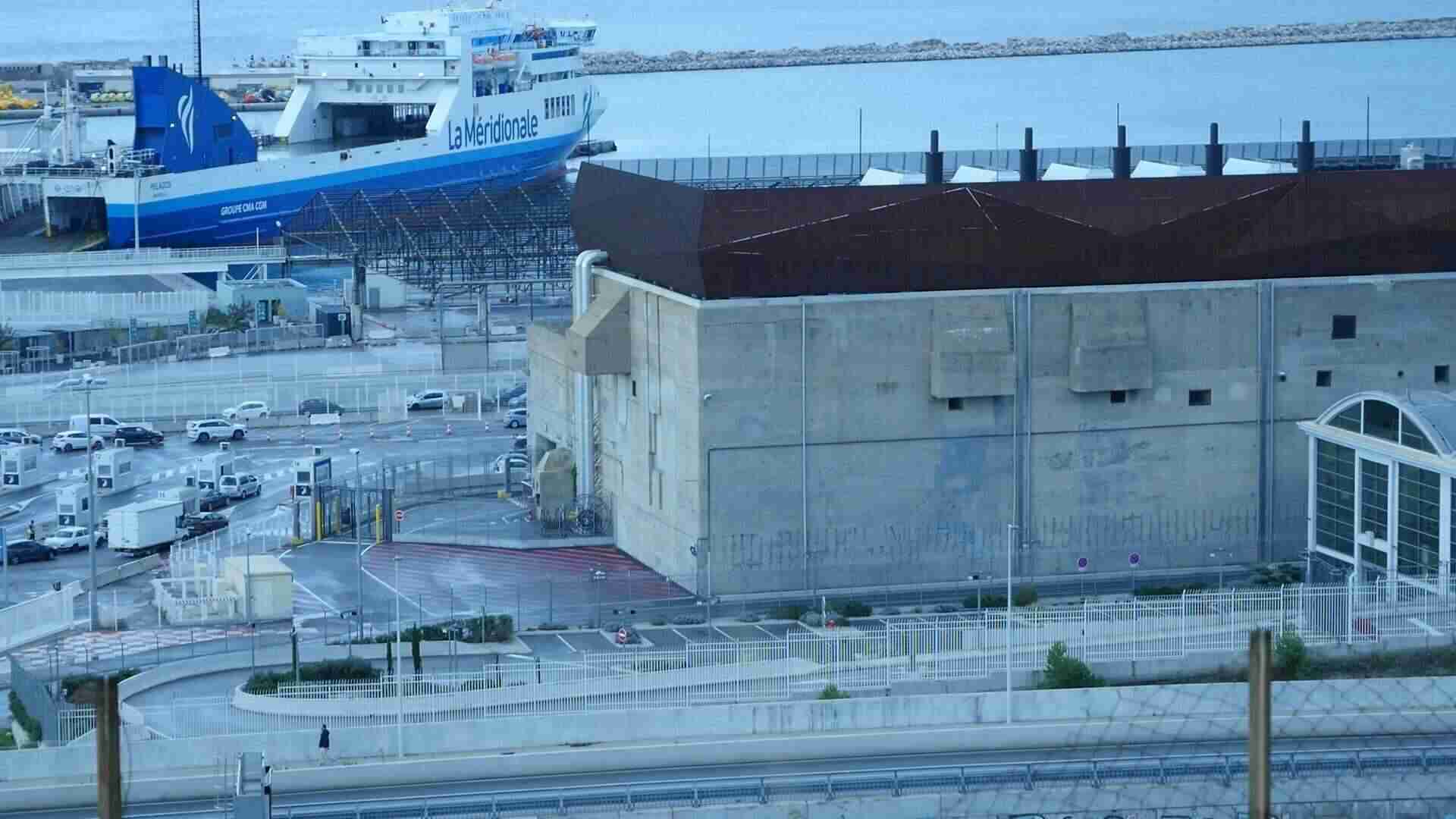
View of the MRS3 data center in Marseille’s Grand Port Maritime. This is the so-called Great Martha building, a former Nazi bunker from the Second World War, purchased by Digital Realty in 2020. Photo taken during the “Le Nuage était sous nos pieds” festival walk on November 9, 2024.
Numerous irregularities have been observed by Provence-Alpes-Côte d’Azur DREAL inspections concerning Digital Realty’s data centers MRS2, MRS3 and MRS4 in Marseille. These under-the-radar irregularities, revealed recently by the independent newspaper Marsactu, are nonetheless documented in inspection reports available for consultation on the Géorisques database.
The most worrying irregularity concerns the MRS3: since 2021 this data center has been subject to repeated leaks of fluorinated gases, thus released into the atmosphere. The DREAL inspection services have repeatedly asked Digital Realty (formerly Interxion) to take the necessary measures to stop these leaks during three years. In October 2023, three years after the first leaks were detected, the company was given formal notice by prefectoral order n°2023-215-MED. Here is an extract from this formal notice (available in full here). :
“Considering that the company Interxion France [former name of Digital Realty] is authorized to operate a data center, named MRS3, located in the commune of Marseille;
Considering that during the site visit on March 3, 2023, the environmental inspector noted that the equipment is not equipped with a functional leak detection device;
Considering that this finding constitutes a breach of the provisions of Article 5 of European Regulation n°517/2014 of April 16, 2014 on fluorinated greenhouse gases;
Considering that during this visit it was also found that the measures taken by the operator are insufficient to prevent the occurrence of recurrent gas leaks into the environment since 2021, which constitutes a failure to comply with the provisions of Article 3.2 of the aforementioned European Regulation No. 517/2014 ;
Considering that the cold production facilities at the MRS3 site have had to be recharged, due to leaks, with 745 kg of R134A refrigerant since 2021, which corresponds in CO2 equivalent to a distance of almost 9 million kilometers driven with a combustion vehicle without malus or ecological bonus (CO2 emissions of around 120g/km);
[…]
Considering further that, given the absence of a leak detection system on the equipment, which by regulation alerts the operator or a maintenance company when a leak results in the loss of at least 10% of the charge of fluid contained in the equipment, does not allow the operator to implement corrective actions limiting the emission of greenhouse gases into the atmosphere, the operator must be required to take the necessary measures to prevent serious and imminent danger to health, public safety or the environment, in accordance with article L.171-8 of the Environment Code;”
The R-134A refrigerant in question here, otherwise known as HFC-134A, is a fluorinated gas that is a major contributor to the greenhouse effect, with a 100-year Global Warming Potential (GWP100) of 1430. These fluorinated refrigerants and their effects on the environment have been known since the 1990s, when they were recognized as the main cause of the hole and thinning of the ozone layer. Some types of refrigerant gas, including those responsible for the hole, have already been banned from circulation. Others, including the one used here by MSR3, are now the subject of binding regulations issued by the European Union following the Kyoto and Paris climate conventions (so-called F-Gas I, II and III regulations). These aim to gradually but completely ban the olluting fluorinated gases by 2030, while new types of non-polluting, greenhouse-free fluorinated gases have already been widely marketed for several years.
Based on the DREAL calculation above, which equates these repeated leaks since 2021 with a CO2 equivalent released into the atmosphere of 9 million km driven by combustion engine, we estimate that this also corresponds to (9M * 0.120 kgCO2eq) 1,080 tonnes of CO2 equivalent emitted since 2021. We could continue the equivalence calculations and reduce this quantity to the emissions per number of inhabitants, per number of swimming pools or per number of Paris-New York flights that it represents. But what concerns us here is the fact that this American giant company, while allowing itself to pollute, is multiplying statements of greenwashing in the press, benefiting moreover from a political climate of praise and connivance from local prefects, elected city officials and regional leaders, even as government services are warning of this pollution. Thus, the president of the Aix-Marseille metropole, Martine Vassal, adressed her New Year’s greetings in January 2023 from the MRS3 data center, the same that was put on notice for these dangerous emissions shortly afterwards. More recently, the city of Marseille’s deputy in charge of sustainable digital technology, Christophe Hugon (Pirate Party), accompanied by representatives of the prefect of the region, the president of the metropole and the president of the Southern Region, were all full of praise for Digital Realty, posing together at the press event organized by the company at the Palais du Pharo to celebrate the 10th anniversary of its presence in Marseille.
These fluorinated gas leaks are not the only irregularities noted by DREAL services during the various inspections of Digital Realty’s data centers in Marseille. The MRS2 data center, in the immediate vicinity of MRS3 and the future MRS5, have also had leaks of fluorinated refrigerants that were not declared to the authorities, even though such declarations are mandatory above a certain quantity, as raised in the DREAL inspection report of March 2023.
Thus, through negligence, Digital Realty is responsible for repeated greenhouse gas emissions. This aggravated negligence, or intentional misconduct (given that the operator was made aware as early as 2021 and that these leaks were repeated thereafter), should be enough to put a stop to Digital Realty’s ongoing rollouts. Yet the opposite is happening. In Marseille: the MRS5 data center construction project has just been granted a positive opinion from the environmental authorities, the city and the prefecture, and even the commissioner in charge of the so-called public inquiry, and this despite some thirty negative opinions (equivalent to three-quarters of the responses) from residents’ associations, environmental organizations such as France Nature Environnement, elected representatives and the collective Le nuage était sous nos pieds responding to this inquiry.
We are all the more concerned by the reading of the DREAL reports that, through the voice of its president in France Fabrice Coquio, Digital Realty widely boasts in the media, in the specialized press and at technical conferences of data center manufacturers, about the environmental exemplarity of MRS3 (the site under formal notice) and of MRS4. According to him, these industrial sites would be models of their kind in ecological terms, “green data centers”, thanks in particular to the so-called “river cooling” system with which they are equipped, but which clearly hasn’t prevented this considerable pollution by fluorinated gases. What’s more, this pollution was concealed by F. Coquio and other Digital Realty executives. A “green data center” with 1080 tonnes of CO2 fluorinated gas pollution emitted over the last three years through intentional negligence, this is the reality that Digital Realty and the local political powers in Marseille hide and dress up with greenwashing.
The river-cooling system: privatizing and monopolizing drinking-quality water resources
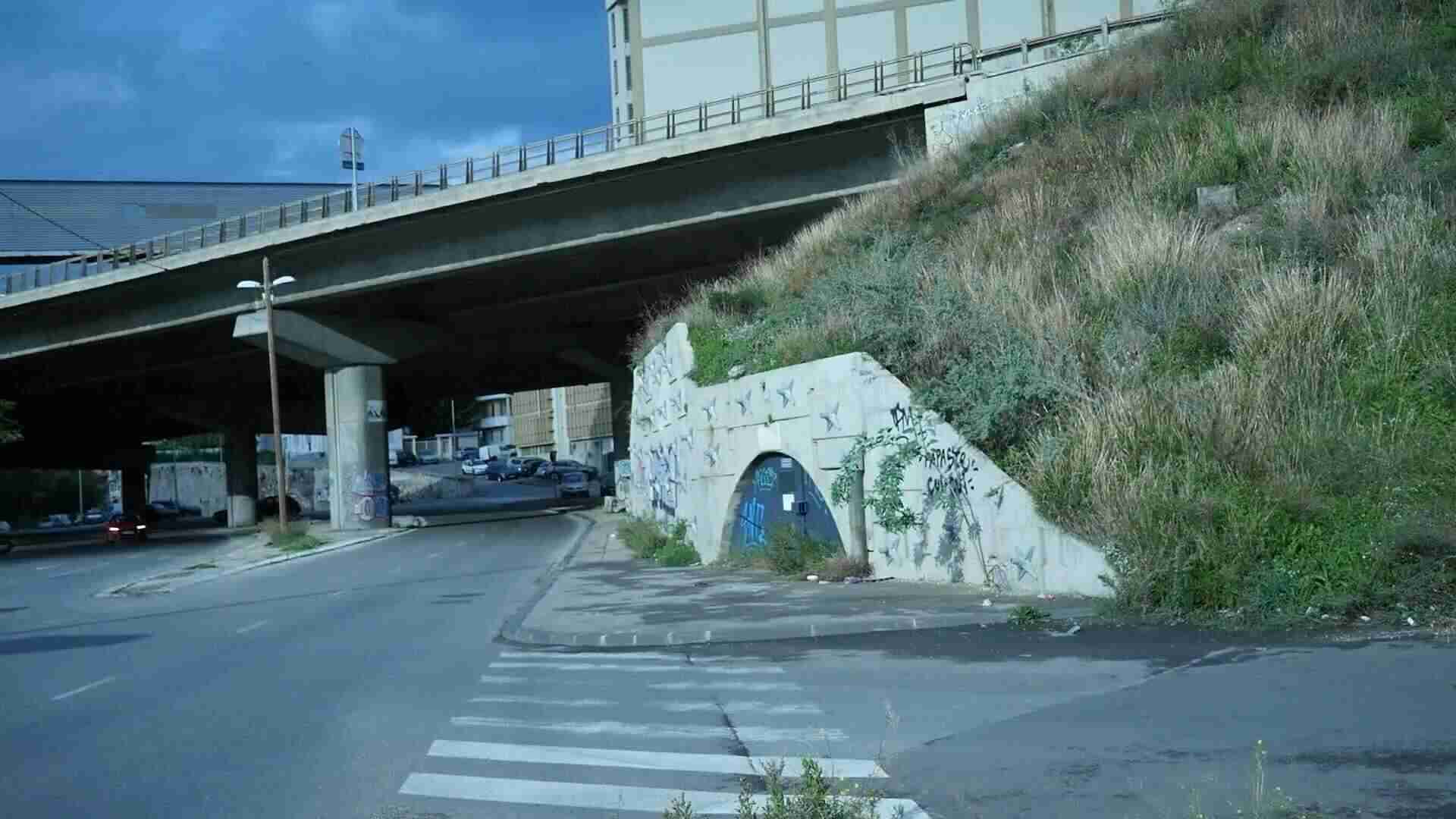
Photo of one of the entrances to the Galerie à La Mer in Marseille. Photo taken during the Le Nuage était sous nos pieds festival walk on November 9, 2024.
The ” Galerie à la Mer”, built in 1905, is a mine drainage galery that evacuates the overflow of water from the former coal mines of the neighboring town of Gardanne, located north of Marseille. This overflow water is discharged into the Mediterranean Sea at Cap Pinède in Marseille. Managed since 2007 by the Bureau de Recherches Géologiques et Minières (Office of Geological and Mining Research, BRGM), the national geological survey authority, the Gallery consists of an upper section, used to evacuate drainage ferruginous water from the former mine to the sea, and a lower section, known as the “cunette”, a drain pipe, which collects and evacuates rainwater runoff and infiltration water from the nearby Massif de l’Étoile. According to the final report document provided by the public inquiry commissioner in 2018, the water in this drain pipe is of “very good quality” and “drinking quality” water that can therefore be used for the population or as a strategic reserve in case of need, in a region prone to droughts.
In 2018, Digital Realty obtained authorization from the Prefecture to divert water from the draining pipe of the Galerie à la Mer for seven years, in order to cool its MRS3 data center. The cool waters of this drain pipe, which are at 15.5 degrees Celsius all year round, are thus captured and injected into a cooling circuit in the data center, to exchange their “frigories” for “calories” via “heat exchangers”. They then return, heated to around 27 degrees, to the Galerie à la Mer, bound for the Mediterranean at Cap Pinède. This system is called “river-cooling“.
While Digital Realty’s head of France, Fabrice Coquio, proclaims in a promotional video, that discharging hot water into the Mediterranean “has no impact on flora and fauna “, the conclusions of the aforementioned public inquiry in 2018, highlighted concerns about the effects of discharging these hot waters into the marine environment, pointing in particular to the “risks of eutrophication” (imbalance in the environment caused by increased concentrations of nitrogen and phosphorus) entailed by the Galerie’s discharges of warmed water into the sea, risks increased in the summer period. But, according to the survey, many other impacts are still unknown, such as “the possible proliferation of filamentous algae“. It should also be noted that this report was based on estimates proposed by Digital Realty at 23.4 degrees, and not the 27 degrees actually observed since the system was implemented. Despite these alerts, the river cooling first implemented for MRS2 and MRS3, has not been paused, but instead extended to MRS4 and MRS5 data centers. The issue of water warmed by these data centers and returned to the marine environment, in a context where warming seas are causing significant mortality rates in submarine biotic communities, is not addressed. No monitoring or serious measurements of the effects of this discharge are published today, according to local collectives such as the Gammares collective or the association of 16th arrondissement residents, directly concerned by these issues.
As early as 2018, during the public inquiry for the construction of the river cooling for MRS3, several communes along the Galerie à la Mer route, between Gardanne and Marseille, expressed reservations about the company’s monopolization of public water and proposed other uses for this water. The conclusions of the inquiry were even along these lines, pointing out that drinking water should first and foremost serve the general interest. The commune of Septème-les-Vallons, for example, called for priority to be given to the possibility of pumping part of the drinking water from the Galerie à la Mer to support agricultural activity and biodiversity, and for the deployment of fire prevention systems (DFCI). The town of Mimet also asked to be allowed to use this freshwater reserve. The Gammares collective, which provides an in-depth analysis of water issues in Marseille, pointed out these issues in September 2024, in its response to the public inquiry into the construction of MRS5, which will also use river cooling :
“At a time when hydrologists are urging sobriety and the regeneration of natural water cycles, the decision to cool data centers so that digital giants can rent space for their servers doesn’t seem to us to be in the general interest. In a context of increasing extreme climatic events due to global warming, where droughts are intensifying and occurring more and more regularly in the Southern Region and elsewhere, jeopardizing the supply of drinking water or water for agri-food use, it would be urgent to systematize and publish all investigations into this common resource that is water. We consider that water should be allocated as much as possible to uses of public utility or for environments that need it. “.
Diversion of fresh drinking water for free cooling of its data centers and discharge of heated water into the sea: this is the reality of Digital Realty’s river cooling system in Marseille.
The river cooling system: misleading greenwashing financed by public money
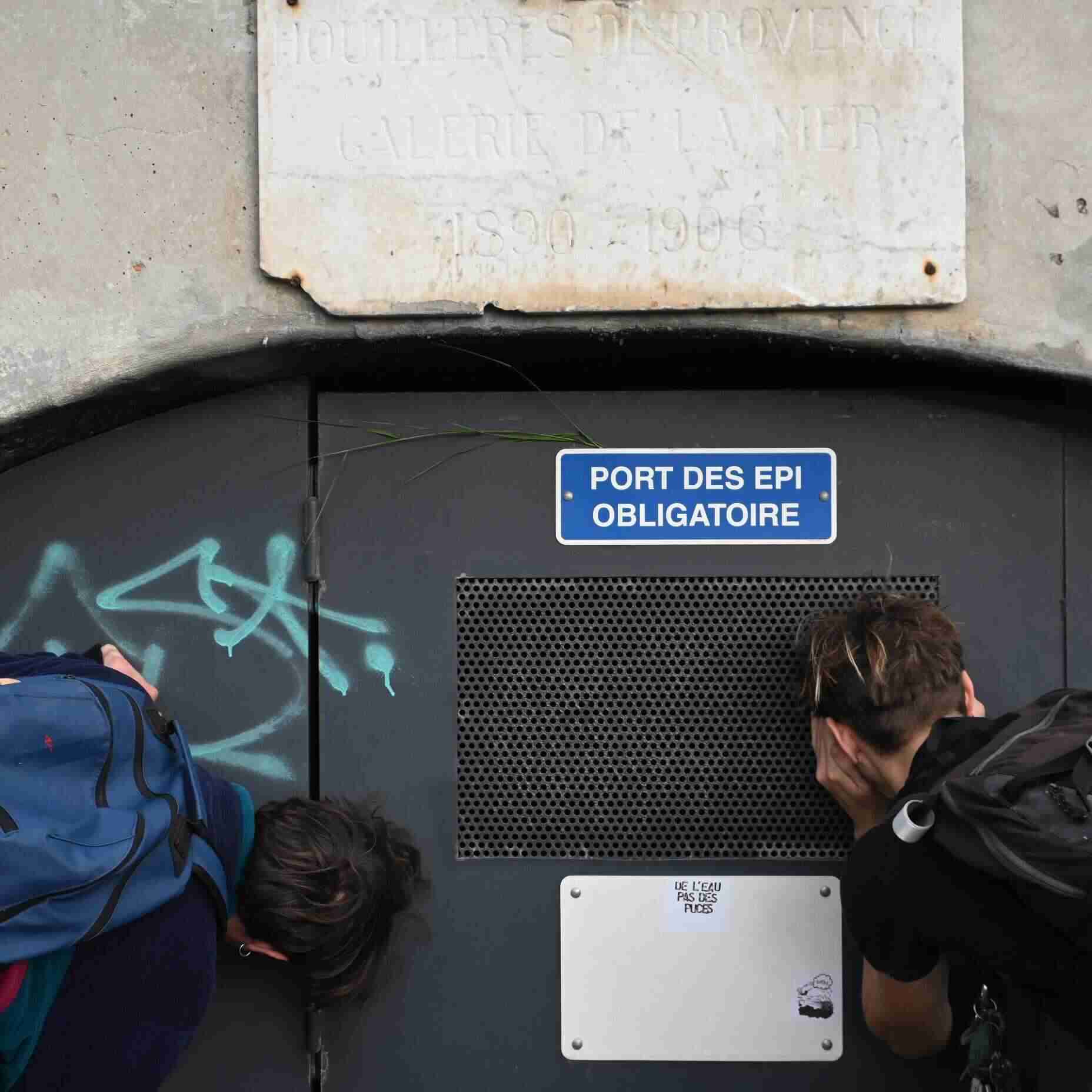
Photo of one of the entrance gates to the Galerie à La Mer on Cap Pinède in Marseille. If you put your ear close to the holes in the gate, you can hear the water flowing and feel the fresh air through. Photo taken during the Le Nuage était sous nos pieds festival walk, November 9, 2024.
River cooling has become a flagship argument in Digital Realty’s communications, in France and around the world. In the general press it is presented as a “green innovative solution minimizing the ecological impact” of the company. In the trade press, Digital Realty boasts of using free water from a public facility. It’s not just the water that’s free for the company. The French state partially funded the work to divert water from the Galerie à la Mer to Digital Realty’s data centers, through two public subsidies. Out of a total investment of around 15 million euros, the Région Sud thus contributed 800.000 euros, while the public agency for ecological transition, ADEME, subsidized the project to the tune of 1.9 million euros in the name of the “decarbonation of our industries“ fund.
In the project management file filed in 2018 by Digital Realty (part of the commissioner’s full report document), we read that the “river cooling” system would reduce electricity consumption for cooling alone by 90% at its data centers in Marseille. In September 2024 its director Fabrice Coquio speaks of a 30% reduction in total electricity consumption for all “river cooling” data centers thanks to this system. However, for its next data center under construction, MRS5, according to figures given by the company during the project’s public inquiry, we note that “river cooling” will reduce total electricity consumption by just 4.33% (calculation based on data on page 107: (241,133,856 kWh – 230,695,705 kWh) / 241,133,856 kWh * 100). In fact, the largest energy expenditure in a data center is for servers. These occupy 79 to 83% of the total energy of the MRS5 data center according to the company (page 107 of the aforementioned file).
The energy expenditure of these data centers, which are constantly growing and expanding, despite optimizations at the margins via methods such as “river cooling“, is clearly on the rise overall, and this is a global trend. These sporadic optimizations lower the costs for the company, while enabling it to maintain or grow its commercial potential, and are therefore interesting for them, but are always and again carried out through the hoarding of new resources that can serve local residents.
Digital Realty’s communication also suggests that “river cooling” would be the only cooling system for data centers. This turns out to be untrue when you read the report. This system does not replace refrigerant-based air-conditioning cooling systems, which cause the fluorinated gas leaks mentioned earlier in the article, but adds to them. The cooling of the company’s data centers in Marseille is done only in small part by “river cooling“. But the most serious part of the Digital Realty executive’s misleading communication is the fact that he claims that the water used for river cooling would be dirty water from the Gardanne mines, as he repeats in the media and the promotional video with Jamy quoted above. This is false, as shown in this video from Interxion (former name of Digital Realty) found on a Vimeo account of an employee of the company, a video that explains well the construction of the river-cooling and its use of groundwater harvested from the draining pipe of the Galerie à la Mer.
Public money used to finance the data centers of a publicly-traded American giant, using a precious common resource, drinking-quality water, while releasing fluorinated gases with a high global warming impact: this the reality of Digital Realty’s data centers today in Marseille. The most ironic part is that it is precisely this river cooling, which the state helped to finance, that now serves as a global media greenwashing argument for the company.
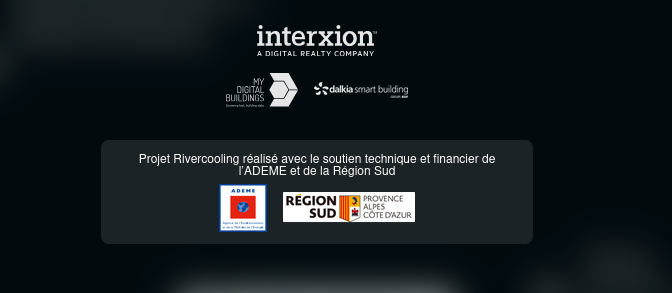
Screenshot of Digital Realty’s river-cooling demonstrator website bearing the inscription: realized with the technical and financial support of ADEME and Région Sud. Last accessed in November 2024: https://river-cooling-interxion.mydigitalbuildings.com/.
Electricity capture at the expense of projects of common interest and of environmental urgency
Although electricity in France, most of which comes from nuclear power, is presented as “green”, it is low-carbon, but not carbon-neutral. Indeed, the carbon intensity of electricity in France is 32 gCO2eq per kilowatt-hour according to France’s electricity transmission system operator RTE. We’re not going to calculate here the CO2 emissions due to the massive use of electrical energy by all of Marseille’s data centers. We have no doubt that this consumption is considerable, and that it is also growing. Indeed, all over France and the world, we’re seeing a trend towards the launch of ever larger, ever more energy-intensive data center projects. The hyperscaler type of data centers are multiplying everywhere, and forecasts are only increasing with the arrival of Artificial Intelligence, which is creating a multiple scaling effect. Artificial Intelligence requires servers with dedicated chips and powerful graphical cards, consuming more, heating more, requiring dedicated cooling systems, profoundly modifying buildings and the entire structure of a data center, causing obsolescence from the graphical chips inside the servers, up to the data center buildings that are all looking to be AI compliant. What interests us here are the systemic effects of these infrastructures and this digital trend that is being imposed on us, the rebound effects they constantly generate and which are never debated.
Digital Realty’s data centers in Marseille use the available electrical energy that the two national energy grid and transmission operators, RTE and Enedis, are able to deliver to Marseille, with current electrical infrastructures. Rather than a simple “use”, this is a real monopolization. For the electrical energy required by these data centers is being captured at the expense of projects of common interest to the city’s environmental emergency. In their report “The spatial and energy impact of data centers on territories” researchers Fanny Lopez and Cécile Diguet noted an initial conflict of use in 2012, to the detriment of the electrification of municipal buses in Marseille (p. 62):
“For Brigitte Loubet, DRIEE’s special heat advisor, and Fabienne Dupuy, assistant to the Enedis Territorial Manager in Seine-Saint-Denis, it’s a real challenge, the demands of energy from data centers can be
blocking for territories. Electricity is ordered on a first-come, first-served basis, queues are forming at various sites. […] A case in point is Marseille, where Mayor Jean-Claude Gaudin had to negotiate with Interxion to get 7 MW back “because they had forgotten to book them for their electric buses”.
This is once again the case today for the electrification of the quays at the Grand Port Maritime de Marseille, an electrification that would enable the many cruise ships, ferries on lines linking the city to Corsica or other Mediterranean cities, and the Shipyard of Marseille to plug-in electrically during their calls, thus avoiding the release into the atmosphere of considerable pollution due to the combustion of fuel oil. This pollution from nitrogen oxides (NOx) and other harmful particles has immediate effects on the health of the nearest residents, but also on all the inhabitants of the city, a city where some 2500 pollution-related deaths are recorded every year according to health authorities. This multi-stage electrification, which has been underway for many years, is insufficient to accommodate the growing summer flow of boats, as Marseille has become a city where polluting cruise tourism is steadily increasing, as the Stop Croisières collective notes and deplores.

Illustration of a campaign denouncing the greenwashing of the electrification of cruise ship docks in Marseille, by the Stop Croisières collective: https://stop-croisieres.org/.
What’s more, this electrification is constantly being postponed or slowed down. In its response to the public inquiry for the construction of MRS5, the federation of organisations of the numerous residents of Marseille’s 16th arrondissement, calling for a halt to the construction of all data centers in the city, writes:
“…] local residents are confronted with air pollution from ships and noise pollution from port activities. GPMM’s deputy general manager has estimated the electrical power still needed for port activities and quayside electrification at 100 to 120 MW. […] The total power of the current data centers amounts to 77 MW, […] the total power of the planned data centers is 107 MW. Digital Realty’s data centers located on the GPMM site are powered by the Saumaty source substation, located in the Saint-André district. Segro’s future data center in Saint André will be supplied by the Septèmes-les-Vallons substation, 11 km away. Is the Saumaty substation saturated? Electrification of the Shipyard of Marseille and the quays in the GPMM is postponed to 2029. Are the
This conflict of electricity usage between data centers and electrification of ship quays is noted by the town council itself in its deliberation of the town council of October 2023, while voting to set up a regulatory commission on data centers. This commission seems perfectly inadequate, as Sébastien Barles, deputy in charge of ecological transition for the city of Marseille, is pointing out. He is calling for a moratorium on the city’s data centers, a moratorium that has been set aside, even though it is an essential step towards beginning to control these rapidly expanding infrastructures. What’s more, little has been revealed by the city about the regulatory commission – which reportedly includes, among others, the head of Digital Realty and the Pirate Party’s eulogistic deputy chairman, Christophe Hugon. This lack of transparency is nothing new, as Marseille elected representatives, have already been singled out in our Technopolice campaign, not only for their political hypocrisy but also for their lack of transparency and failure to respond to FOIA (Freedom of Information Aceess) requests, which are nonetheless a constitutional right and obligation in France.
Urban heat hot spots
These data centers that are piling up around Marseille are veritable “overheating toasters” to use the terms of Laurent Lhardit, deputy mayor of Marseille, in charge of economic dynamism, employment and sustainable tourism.
In fact, the laws of thermodynamics mean that the heat removed from the servers in these data centers doesn’t disappear, but finds its way back into the air surrounding the buildings, into the clouds, the real ones, or into seawater warmed by river cooling. In a warm-climate city like Marseille, prone to increasingly frequent heatwaves, it’s worrying to continue ignoring this problem, which is becoming vital. Scientists are already warning of the effects these repeated heat peaks are having on human life, and of the fact that in the more or less short term, whole regions of our planet and Europe will gradually become uninhabitable due to this unbearable heat (see for example this atlas of predictions of deadly heat to come around the world).
It’s high time to think about urban planning in terms of green spaces, with plants that cool and create shade, to make cities more livable, less harmful to health and more sustainable in the face of ongoing environmental change.

Photo of toaster on a fire. Nicholas.scipioni, CC BY 4.0 https://creativecommons.org/licenses/by/4.0, via Wikimedia Commons.
Recovering “waste heat” or how to perpetuate the ecocidal status quo
The use of “waste heat” consists in recovering the heat emitted by data centers, which would then become, in an ideal technomagical circular economy, a kind of digital boiler capable of heating buildings or Olympic swimming pools. In reality, these so-called “fatal” heat recovery projects, are not always effective or even possible. For this to work, heat recovery would have to take place as close as possible to the source, i.e. the data center, as the greater the distance, the more significant the heat losses will be. But given the noise and other atmospheric nuisances generated by a data center, heating inhabited buildings doesn’t seem very attractive. Not to mention the fact that, in cities with warm climates like Marseille, the heat recovered would only be useful for a few months of the year, with the heat released by these data centers becoming problematic the majority of the time. A report by the Uptime Insitute concluded in 2023 that the cases where waste heat reuse can be effective are rare, unsystematic, located in cold climate zones, and can even sometimes be counterproductive (page 8):
The option to reuse data center waste heat is typically limited to colder climates and may require connections to district heating systems or manufacturing sites. The availability of such connections and / or facilities is heavily concentrated in Northern Europe. Configuring a facility for waste heat reuse often increases energy use (since heat pumps are needed to increase outgoing heat temperature) but can lower overall carbon emissions by reducing energy that would otherwise be needed for heating.
But the real problem, once again, is not technical. As these systems are costly and of no commercial interest to data centers, the latter largely prefer to avoid them, or else constantly promise that they will implement them in the near evercoming future. This is exactly what the France Datacenter lobby set out to do in 2022, as shown by the mandatory declaration of their lobbying acivities to the Haute Autorité pour la Transparence de la Vie Publique (High Authority for the Transparency of Public Life, HATVP), where we can read, among other actions to reduce taxation or escape polluter obligations:
List of activity sheets
[…]
Withdraw an amendment to the renewable energies bill aimed at making it compulsory to reuse waste heat.
This activity has been a success, with the amendment making the recovery of waste heat mandatory having been withdrawn from the renewable energies bill, in favor of “incentive measures” which have consisted, since 2015 at least, of public funding, via an ADEME public fund again, aimed to finance the waste heat reuse projects that data centers would be kind enough to undertake. The few cases that do exist serve, as in the case of “river cooling“, as over-publicized greenwashing examples. This allows once again, data centre companys to continue profiting from territories without limits, by making people believe that technomagical solutions are possible, while working to push back the regulatory obligations that would force them to implement them. And meanwhile, public institutions are entirely at their service.
Exponential growth and bloody colonial extractivism
While all of Digital Realty’s data centers in Marseille, MRS1 to MRS5, have a maximum electrical capacity of 98 Megawatts (16+16+24+20+22), Digital Realty’s next data center in Bouc-Bel-Air, MRS6, will have a capacity of 50 Megawatts on its own. The one at PAR08 in La Courneuve, currently the largest in France, also by Digital Realty, has a capacity of 120 MW. The one to be built at Dugny, near Paris in Seine-Saint Denis, also by Digital Realty and which will be the future largest data center in France, will have a capacity of 200 megawatts, equivalent to 20% of the power of an EPR nuclear reactor. The total digital footprint was estimated at 2.5% of France’s annual carbon footprint in 2020, with data centers accounting for around 16% of it, according to the Ademe and Arcep official reports. This digital footprint is set to double by 2040, and data centers could play a major role in it, according to an expert opinion from Ademe in October 2024.
On a global scale, hyperscale data centers already constituted 37% of global data center capacity in 2022, and should account for 50% by 2027, with this share rising steadily. On the other hand, the water requirements of these “hyperscalers” are steadily increasing. Under pressure from public authorities in 2023, Google revealed that its data centers, in the USA alone, used more than 16 billion liters of water per year for cooling. We also recently learned that its CO2 emissions have increased by 48% over the past 5 years, and its water usage is expected to increase by a further 20% by 2030. Microsoft, meanwhile, has seen the water usage of its data centers increase by 34% in 2022 alone, due to its use of AI, and we can see this plethora of investment announcements for new data centers being built for AI, foreshadowing even stronger and worrying future growth.
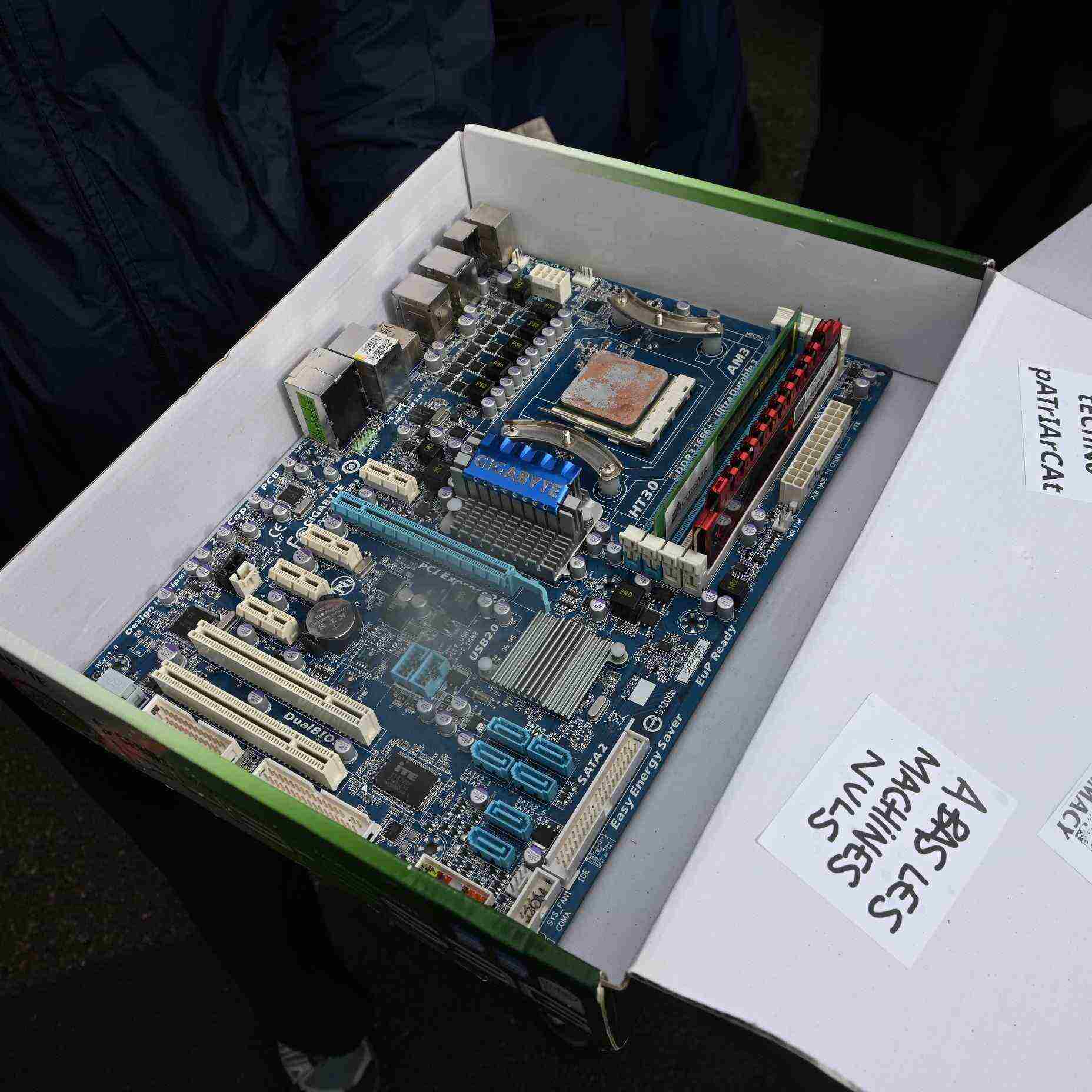
Photo of an “Easy Energy Saver” Gigabyte motherboard, manufactured in China, designed in Taiwan, featuring numerous electronic components and chips, shown and discussed upon during the “Nuage était sous nos pieds” festival walk on November 9, 2024 in Marseille.
But these institutional computations or those coming from digital giants, based purely on electrical energy consumption and its carbon footprint, sometimes on water consumption for cooling, do not take into account the totality of the conflicts, monopolies of lives and of vital resources that this digital technology causes. Starting with the extraction phase of the many minerals that make up the processor chips and graphical cards that these data centers contain by the thousands. Génération Lumière, an environmental association operating in both France and the Democratic Republic of Congo (DRC), has for years been denouncing the unscrupulous extractivism of minerals strategic to our digital industries. Indeed, the DRC contains 70% of the world’s cobalt, used to manufacture the lithium batteries in our electric cars, smartphones and data centers. The DRC is also a land of coltan, copper and gold extraction, all minerals used for electronic chips. And this extraction, which serves the digital industries as well as giants such as Apple, Nvidia and AMD (two main manufacturers of graphical chips) and now even Google, Amazon and Microsoft, is multiplied by the arrival of AI, which is inserted everywhere in devices and servers. However, this extraction is, as Génération Lumière puts it, “tainted with our blood“, takes place in inhuman conditions of exploitation of workers, and creates numerous conflicts and massacres on the territory, in addition to the social and environmental problems due to the mining itself.
These institutional calculations also leave out, or purposely ignore, the issues involved in the manufacturing of electronic chips, from the purification of the minerals laid on the silicon wafers, to their becoming chips. The StopMicro french collective, which fights against the monopolization of resources and the nuisance caused by Grenoble’s industries, and in particular the microelectronics industries of Soitec and STMicroelectronics, reminds us that, “Behind climate disruption and socio-environmental injustices, there are political decisions, companies and economic interests that condition our choices of society“. In one of its numerous analysis brochures and in their new book called “Toujours puce” (Always a chip), StopMicro carries out an in-depth technical, social, political and environmental investigation. Using its own territory as an example, it explains how drinking water is monopolized and polluted to manufacture connected water bottles equiped with chips from STMicroelectronics or Soitec, when it’s not being used to equip weapons that are being exported to serve ongoing colonial wars.
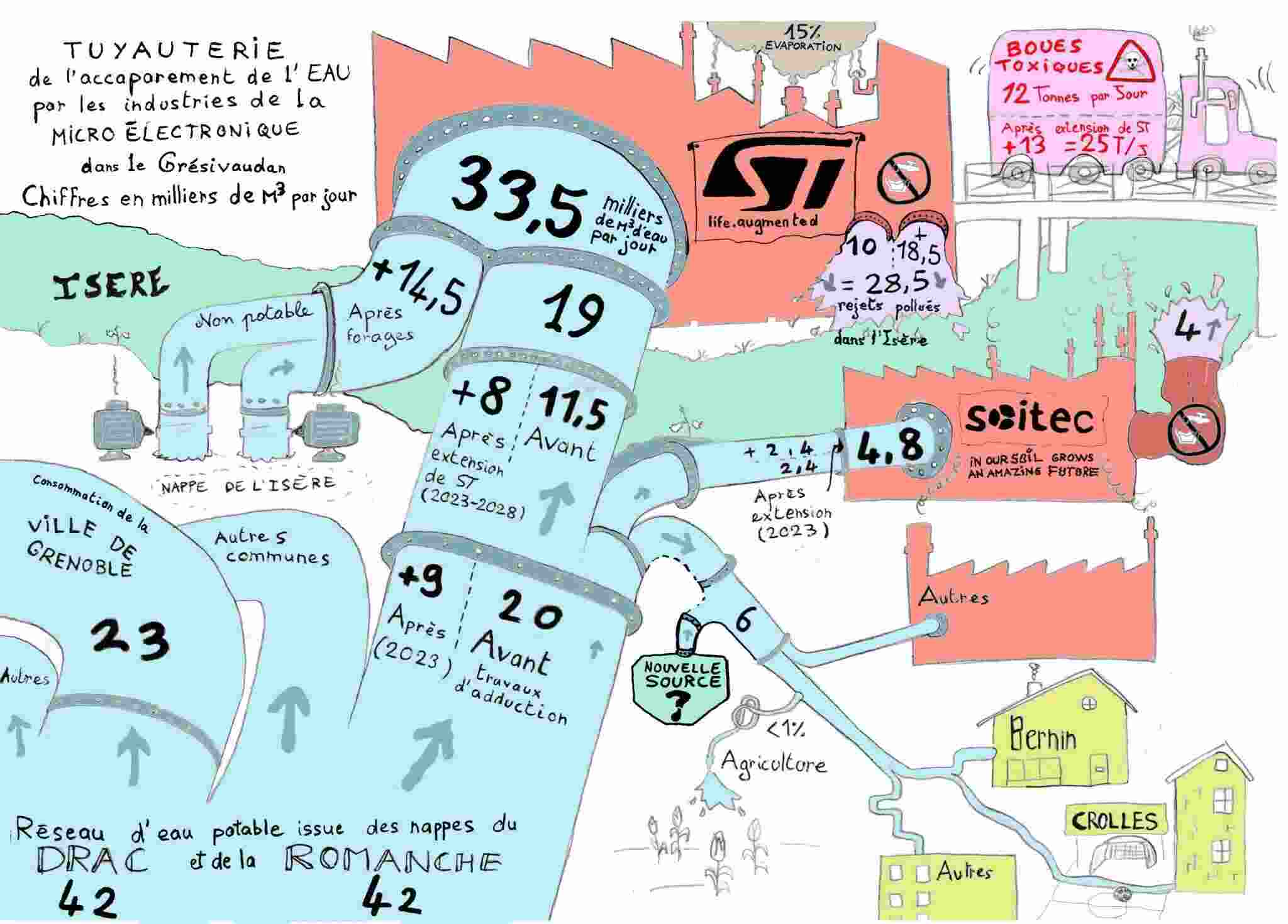
Poster designed by the StopMicro collective in Grenoble: https://stopmicro38.noblogs.org/files/2024/04/tuyauterie-2048×1470.jpg.
h2>This technology is not ours
Looking at the list of Digital Realty’s main customers, we find a massive number of players with questionable digital practices towards digital fundamental rights and current regulations. Fabrice Coquio, president of Digital Realty France, declared not long ago “Without us, there is no Internet“, before listing a good number of the clients of his Marseille data centers: Facebook, Amazon, Microsoft, Netflix, Disney+, Zoom, Oracle, Youtube… The MRS3 data center, where repeated releases of highly polluting fluorinated gases have occurred, houses Microsoft’s “cloud” services deployed in our public city offices, public schools, colleges, high schools and universities, forcing every pupil from an early age to create Microsoft accounts with no or little means of objecting.
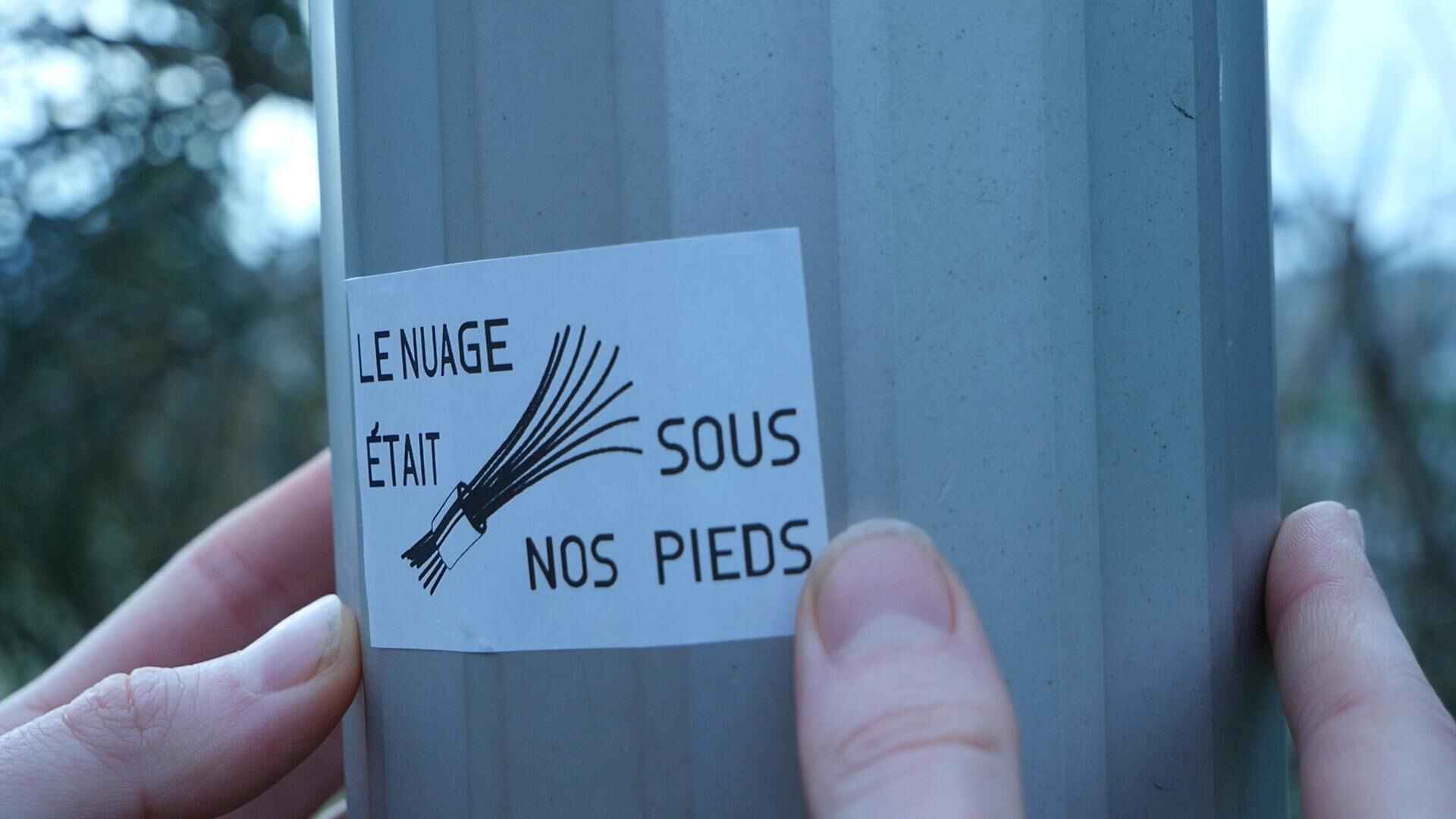
Sticker Le nuage était sous nos pieds on a street pole. Photo taken during the Le Nuage était sous nos pieds festival walk on November 9, 2024. Sticker made during the festival’s workshop organized by the transfeminist hackerspace Fluidspace in Marseille.
As our work at La Quadrature du Net since its inception over 15 years ago also shows, notably through the group action campaign against GAFAM, these players have monopolized and turned the Internet into a giant commercial space, where reigns violence against minority communities and discrimination of all kinds. These players, who illegally and immorally use our personal data to impose advertising on us, pollute our online spaces, our brains, and monopolize our attention with algorithms that play on our cognitive biases and aim to create psychological dependencies. Today, advertising is in turn responsible for worsening the environmental crisis, through the overconsumption and the unsustainable model it generates and constantly feeds. Coupled with the marketed and organized obsolescence of every consumer object, whether digital or not, aided and abetted by polluting digital industrial infrastructures, this advertising, which is largely controlled by GAFAM and tech giants, is one of the major causes of our socio-environmental and systemic crisis worsening.
The public money that the State so easily puts into the hands of such polluters, as illustrated by the “decarbonization of our industries” fund mentioned above as well as the various public contracts signed with these tech giants, is thus distributed to the detriment of public projects of common interest such as the electrification of public facilities, the constitution of water reserves, or even the air we breathe and the city we live in. These projects of general interest, sometimes literally vital, are left to one side as priority is constantly given to digital growth, which involves the increasing installation of data centers and other digital infrastructure.
This world is not ours
This digital domination, of which submarine digital cables and data centers are the backbone, imposed by Silicon Valley’s hegemonic vision and by state policies complicit with unscrupulous tech giants, is not ours.
This Internet, which reproduces colonial dynamics and is based on the colonization of soil resources, minerals, water in our territories, but also the colonization of our bodies and mental spaces, structured around the massive collection of data on our lives, an infinite source of power and profit, is not ours. This digital technology, that reinforces domination and inequality, founded on the normativity of our behavior, on predictive policing and automated decision-making, designed to control us and to enforce surveillance on us, the better to repress our legitimate anger, is not ours. This digital technology, which in turn is responsible for the unprecedented socio-environmental crisis that we are currently living, is not ours, and we refuse it.
Our world is a world of care, care for ourselves, for each other, and for the Earth. Our digital world is that of another technology, one that helps us to protect ourselves from surveillance and oppression, which helps us to carry and shared and common knowledge, which allows us to hack, tweak and create tools, alternative servers, decentralized networks in order to better organize ourselves and make other worlds possible.
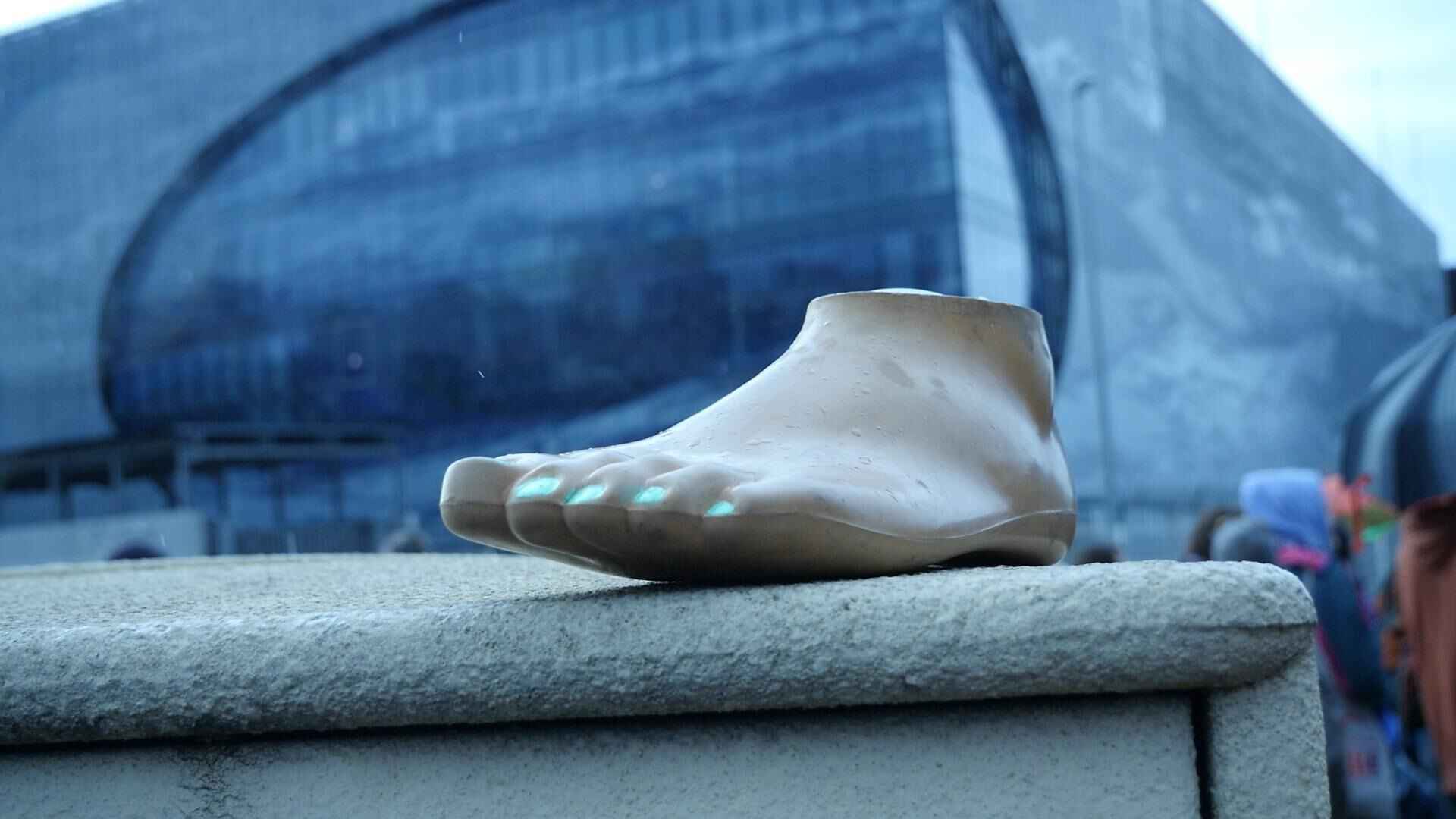
Photo of the MRS4 data center in Marseille in the background. In the foreground the “foot” plastic stand used to hold stickers made by the transfeminist hackerspace Fluidspace, during the festival Le nuage était sous nos pieds, on November 8, 9 and 10, 2024 in Marseille.
To support us in our fights, and in particular in our work around ecological and digital issues, please consider making a donation to our organisation!


